Corporate Social Responsibility and Environmental Management
VerifiedAdded on 2020/10/22
|19
|6654
|285
AI Summary
This assignment delves into the realm of corporate social responsibility (CSR) and environmental management, examining the role of businesses in addressing societal and environmental challenges. The provided references and readings cover a range of topics, from university-industry linkages to sustainable branding and energy security. The assignment is likely geared towards students in business, management, or related fields, aiming to equip them with a deeper understanding of CSR and environmental management principles and practices.
Contribute Materials
Your contribution can guide someone’s learning journey. Share your
documents today.
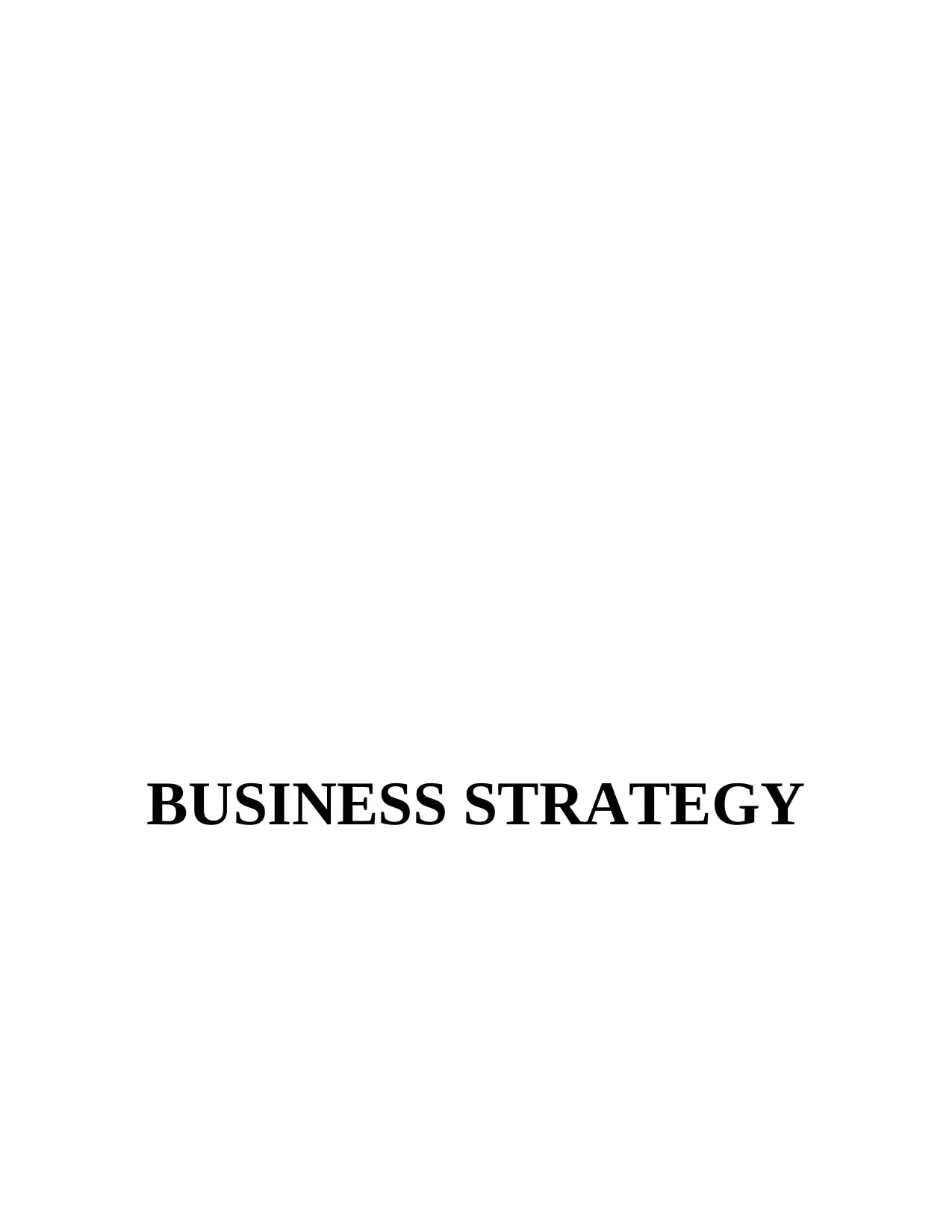
BUSINESS STRATEGY
Secure Best Marks with AI Grader
Need help grading? Try our AI Grader for instant feedback on your assignments.
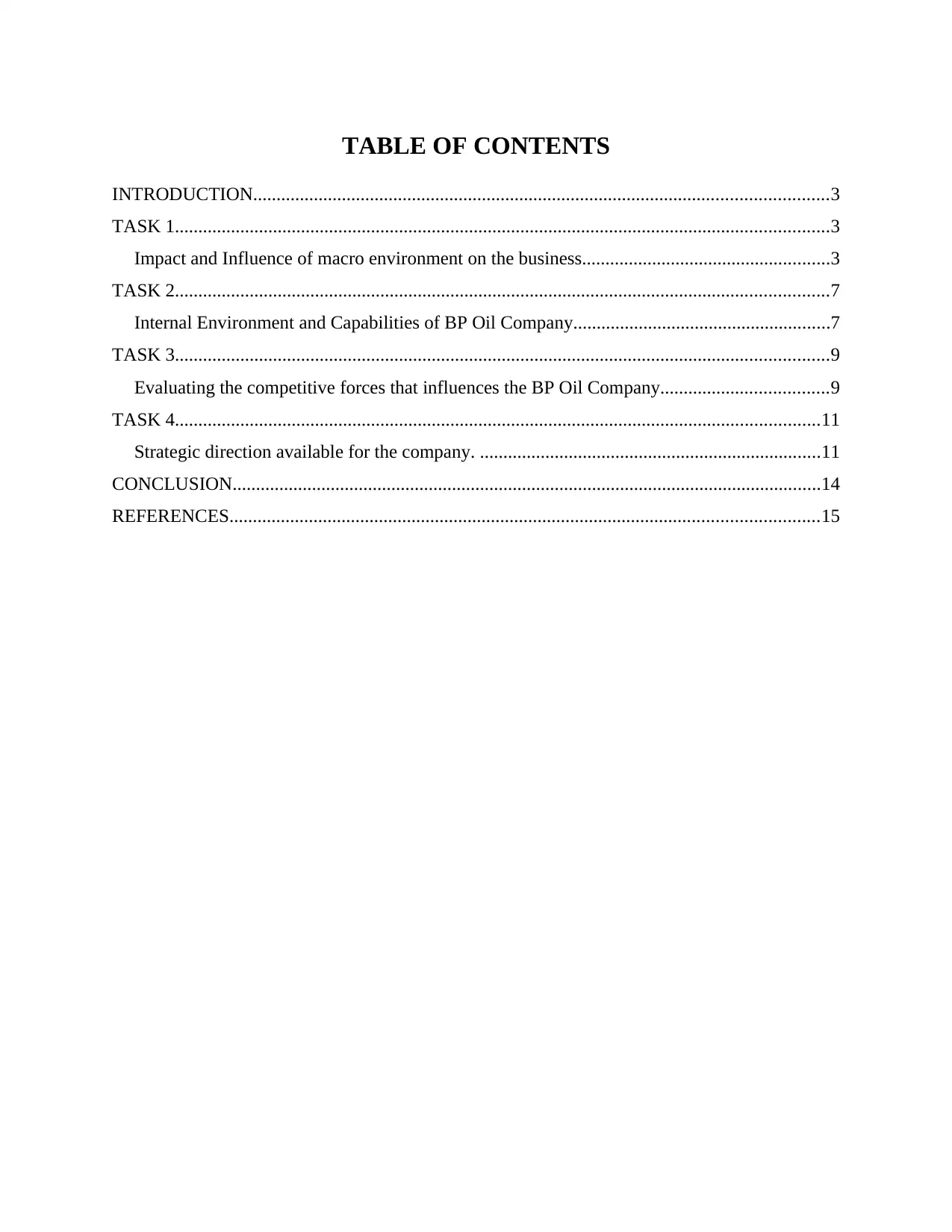
TABLE OF CONTENTS
INTRODUCTION...........................................................................................................................3
TASK 1............................................................................................................................................3
Impact and Influence of macro environment on the business.....................................................3
TASK 2............................................................................................................................................7
Internal Environment and Capabilities of BP Oil Company.......................................................7
TASK 3............................................................................................................................................9
Evaluating the competitive forces that influences the BP Oil Company....................................9
TASK 4..........................................................................................................................................11
Strategic direction available for the company. .........................................................................11
CONCLUSION..............................................................................................................................14
REFERENCES..............................................................................................................................15
INTRODUCTION...........................................................................................................................3
TASK 1............................................................................................................................................3
Impact and Influence of macro environment on the business.....................................................3
TASK 2............................................................................................................................................7
Internal Environment and Capabilities of BP Oil Company.......................................................7
TASK 3............................................................................................................................................9
Evaluating the competitive forces that influences the BP Oil Company....................................9
TASK 4..........................................................................................................................................11
Strategic direction available for the company. .........................................................................11
CONCLUSION..............................................................................................................................14
REFERENCES..............................................................................................................................15
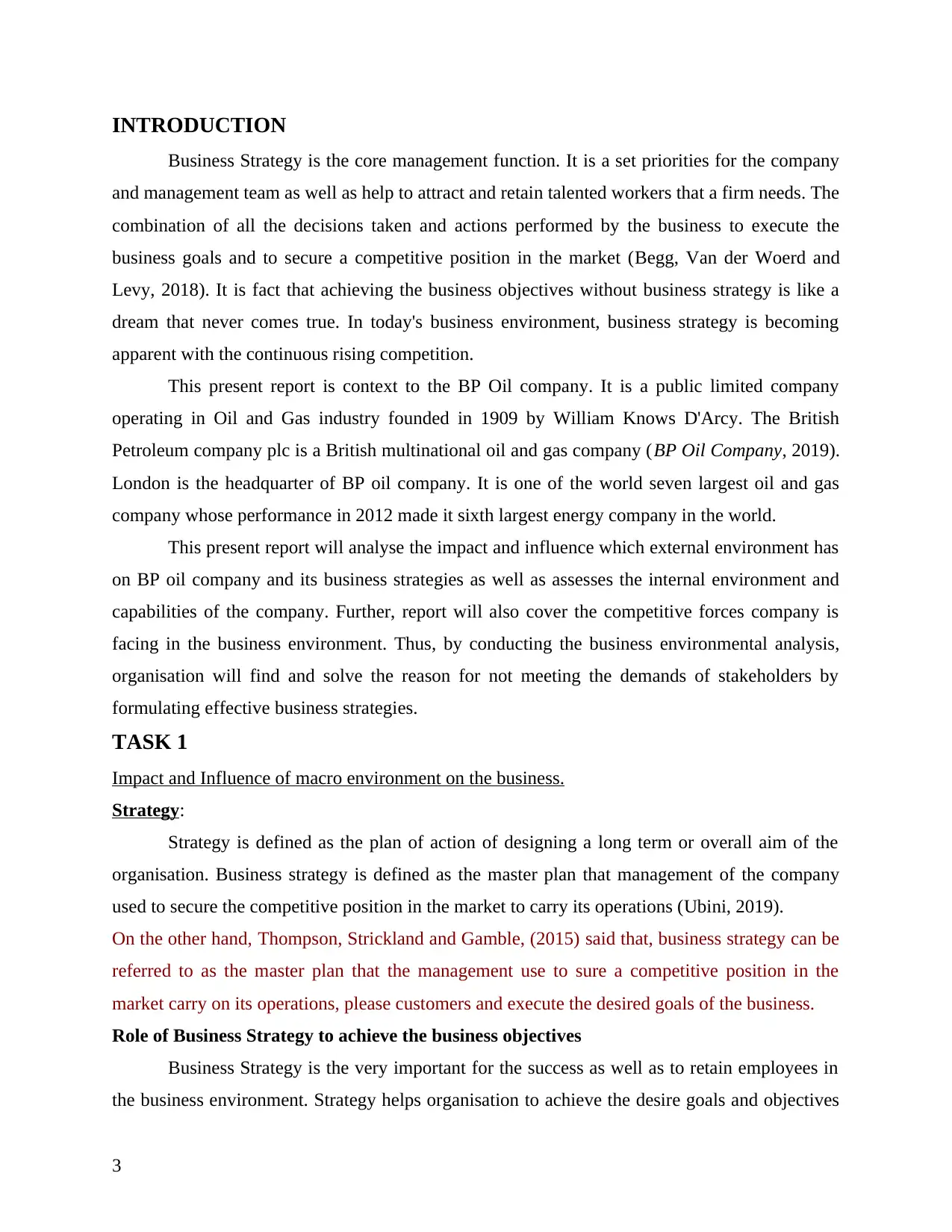
INTRODUCTION
Business Strategy is the core management function. It is a set priorities for the company
and management team as well as help to attract and retain talented workers that a firm needs. The
combination of all the decisions taken and actions performed by the business to execute the
business goals and to secure a competitive position in the market (Begg, Van der Woerd and
Levy, 2018). It is fact that achieving the business objectives without business strategy is like a
dream that never comes true. In today's business environment, business strategy is becoming
apparent with the continuous rising competition.
This present report is context to the BP Oil company. It is a public limited company
operating in Oil and Gas industry founded in 1909 by William Knows D'Arcy. The British
Petroleum company plc is a British multinational oil and gas company (BP Oil Company, 2019).
London is the headquarter of BP oil company. It is one of the world seven largest oil and gas
company whose performance in 2012 made it sixth largest energy company in the world.
This present report will analyse the impact and influence which external environment has
on BP oil company and its business strategies as well as assesses the internal environment and
capabilities of the company. Further, report will also cover the competitive forces company is
facing in the business environment. Thus, by conducting the business environmental analysis,
organisation will find and solve the reason for not meeting the demands of stakeholders by
formulating effective business strategies.
TASK 1
Impact and Influence of macro environment on the business.
Strategy:
Strategy is defined as the plan of action of designing a long term or overall aim of the
organisation. Business strategy is defined as the master plan that management of the company
used to secure the competitive position in the market to carry its operations (Ubini, 2019).
On the other hand, Thompson, Strickland and Gamble, (2015) said that, business strategy can be
referred to as the master plan that the management use to sure a competitive position in the
market carry on its operations, please customers and execute the desired goals of the business.
Role of Business Strategy to achieve the business objectives
Business Strategy is the very important for the success as well as to retain employees in
the business environment. Strategy helps organisation to achieve the desire goals and objectives
3
Business Strategy is the core management function. It is a set priorities for the company
and management team as well as help to attract and retain talented workers that a firm needs. The
combination of all the decisions taken and actions performed by the business to execute the
business goals and to secure a competitive position in the market (Begg, Van der Woerd and
Levy, 2018). It is fact that achieving the business objectives without business strategy is like a
dream that never comes true. In today's business environment, business strategy is becoming
apparent with the continuous rising competition.
This present report is context to the BP Oil company. It is a public limited company
operating in Oil and Gas industry founded in 1909 by William Knows D'Arcy. The British
Petroleum company plc is a British multinational oil and gas company (BP Oil Company, 2019).
London is the headquarter of BP oil company. It is one of the world seven largest oil and gas
company whose performance in 2012 made it sixth largest energy company in the world.
This present report will analyse the impact and influence which external environment has
on BP oil company and its business strategies as well as assesses the internal environment and
capabilities of the company. Further, report will also cover the competitive forces company is
facing in the business environment. Thus, by conducting the business environmental analysis,
organisation will find and solve the reason for not meeting the demands of stakeholders by
formulating effective business strategies.
TASK 1
Impact and Influence of macro environment on the business.
Strategy:
Strategy is defined as the plan of action of designing a long term or overall aim of the
organisation. Business strategy is defined as the master plan that management of the company
used to secure the competitive position in the market to carry its operations (Ubini, 2019).
On the other hand, Thompson, Strickland and Gamble, (2015) said that, business strategy can be
referred to as the master plan that the management use to sure a competitive position in the
market carry on its operations, please customers and execute the desired goals of the business.
Role of Business Strategy to achieve the business objectives
Business Strategy is the very important for the success as well as to retain employees in
the business environment. Strategy helps organisation to achieve the desire goals and objectives
3
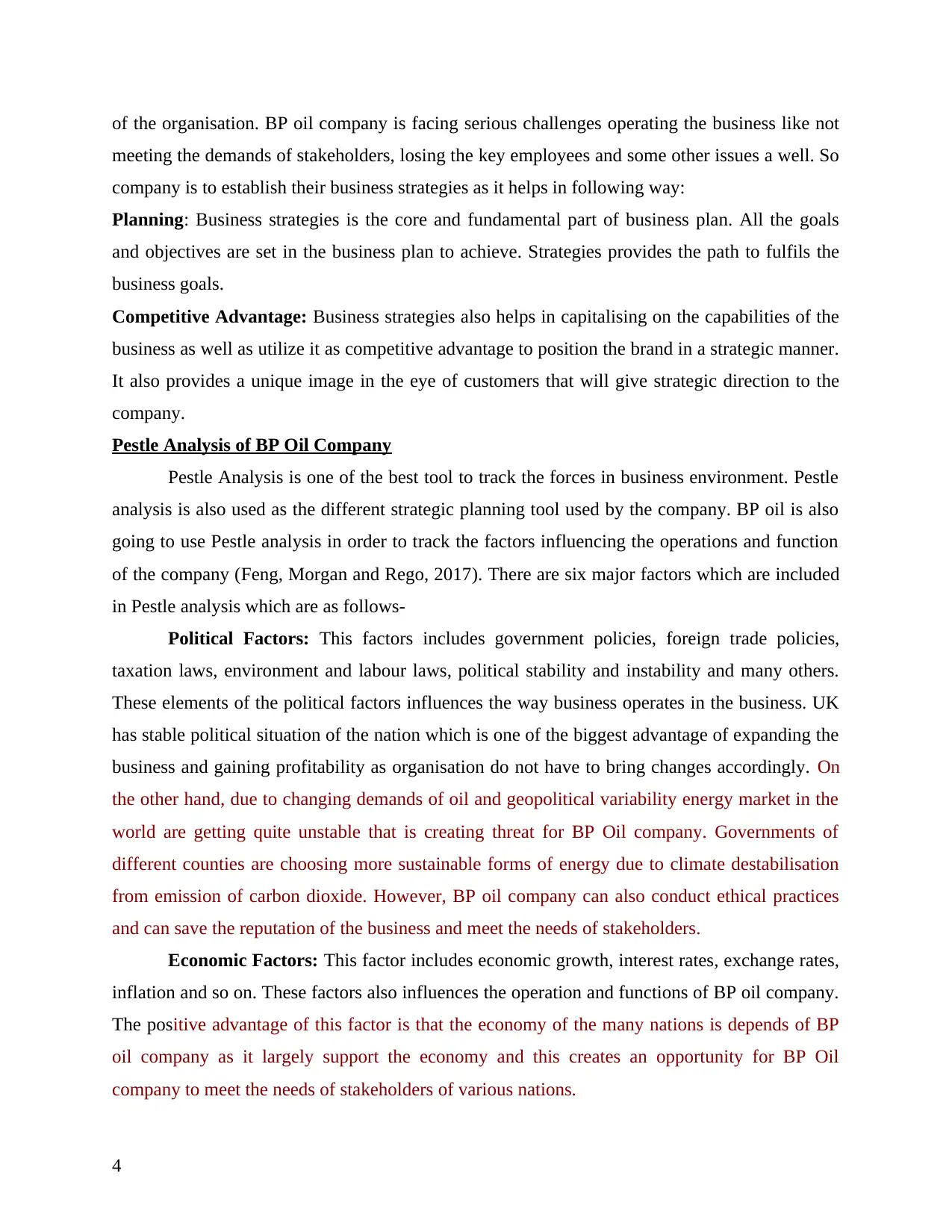
of the organisation. BP oil company is facing serious challenges operating the business like not
meeting the demands of stakeholders, losing the key employees and some other issues a well. So
company is to establish their business strategies as it helps in following way:
Planning: Business strategies is the core and fundamental part of business plan. All the goals
and objectives are set in the business plan to achieve. Strategies provides the path to fulfils the
business goals.
Competitive Advantage: Business strategies also helps in capitalising on the capabilities of the
business as well as utilize it as competitive advantage to position the brand in a strategic manner.
It also provides a unique image in the eye of customers that will give strategic direction to the
company.
Pestle Analysis of BP Oil Company
Pestle Analysis is one of the best tool to track the forces in business environment. Pestle
analysis is also used as the different strategic planning tool used by the company. BP oil is also
going to use Pestle analysis in order to track the factors influencing the operations and function
of the company (Feng, Morgan and Rego, 2017). There are six major factors which are included
in Pestle analysis which are as follows-
Political Factors: This factors includes government policies, foreign trade policies,
taxation laws, environment and labour laws, political stability and instability and many others.
These elements of the political factors influences the way business operates in the business. UK
has stable political situation of the nation which is one of the biggest advantage of expanding the
business and gaining profitability as organisation do not have to bring changes accordingly. On
the other hand, due to changing demands of oil and geopolitical variability energy market in the
world are getting quite unstable that is creating threat for BP Oil company. Governments of
different counties are choosing more sustainable forms of energy due to climate destabilisation
from emission of carbon dioxide. However, BP oil company can also conduct ethical practices
and can save the reputation of the business and meet the needs of stakeholders.
Economic Factors: This factor includes economic growth, interest rates, exchange rates,
inflation and so on. These factors also influences the operation and functions of BP oil company.
The positive advantage of this factor is that the economy of the many nations is depends of BP
oil company as it largely support the economy and this creates an opportunity for BP Oil
company to meet the needs of stakeholders of various nations.
4
meeting the demands of stakeholders, losing the key employees and some other issues a well. So
company is to establish their business strategies as it helps in following way:
Planning: Business strategies is the core and fundamental part of business plan. All the goals
and objectives are set in the business plan to achieve. Strategies provides the path to fulfils the
business goals.
Competitive Advantage: Business strategies also helps in capitalising on the capabilities of the
business as well as utilize it as competitive advantage to position the brand in a strategic manner.
It also provides a unique image in the eye of customers that will give strategic direction to the
company.
Pestle Analysis of BP Oil Company
Pestle Analysis is one of the best tool to track the forces in business environment. Pestle
analysis is also used as the different strategic planning tool used by the company. BP oil is also
going to use Pestle analysis in order to track the factors influencing the operations and function
of the company (Feng, Morgan and Rego, 2017). There are six major factors which are included
in Pestle analysis which are as follows-
Political Factors: This factors includes government policies, foreign trade policies,
taxation laws, environment and labour laws, political stability and instability and many others.
These elements of the political factors influences the way business operates in the business. UK
has stable political situation of the nation which is one of the biggest advantage of expanding the
business and gaining profitability as organisation do not have to bring changes accordingly. On
the other hand, due to changing demands of oil and geopolitical variability energy market in the
world are getting quite unstable that is creating threat for BP Oil company. Governments of
different counties are choosing more sustainable forms of energy due to climate destabilisation
from emission of carbon dioxide. However, BP oil company can also conduct ethical practices
and can save the reputation of the business and meet the needs of stakeholders.
Economic Factors: This factor includes economic growth, interest rates, exchange rates,
inflation and so on. These factors also influences the operation and functions of BP oil company.
The positive advantage of this factor is that the economy of the many nations is depends of BP
oil company as it largely support the economy and this creates an opportunity for BP Oil
company to meet the needs of stakeholders of various nations.
4
Secure Best Marks with AI Grader
Need help grading? Try our AI Grader for instant feedback on your assignments.
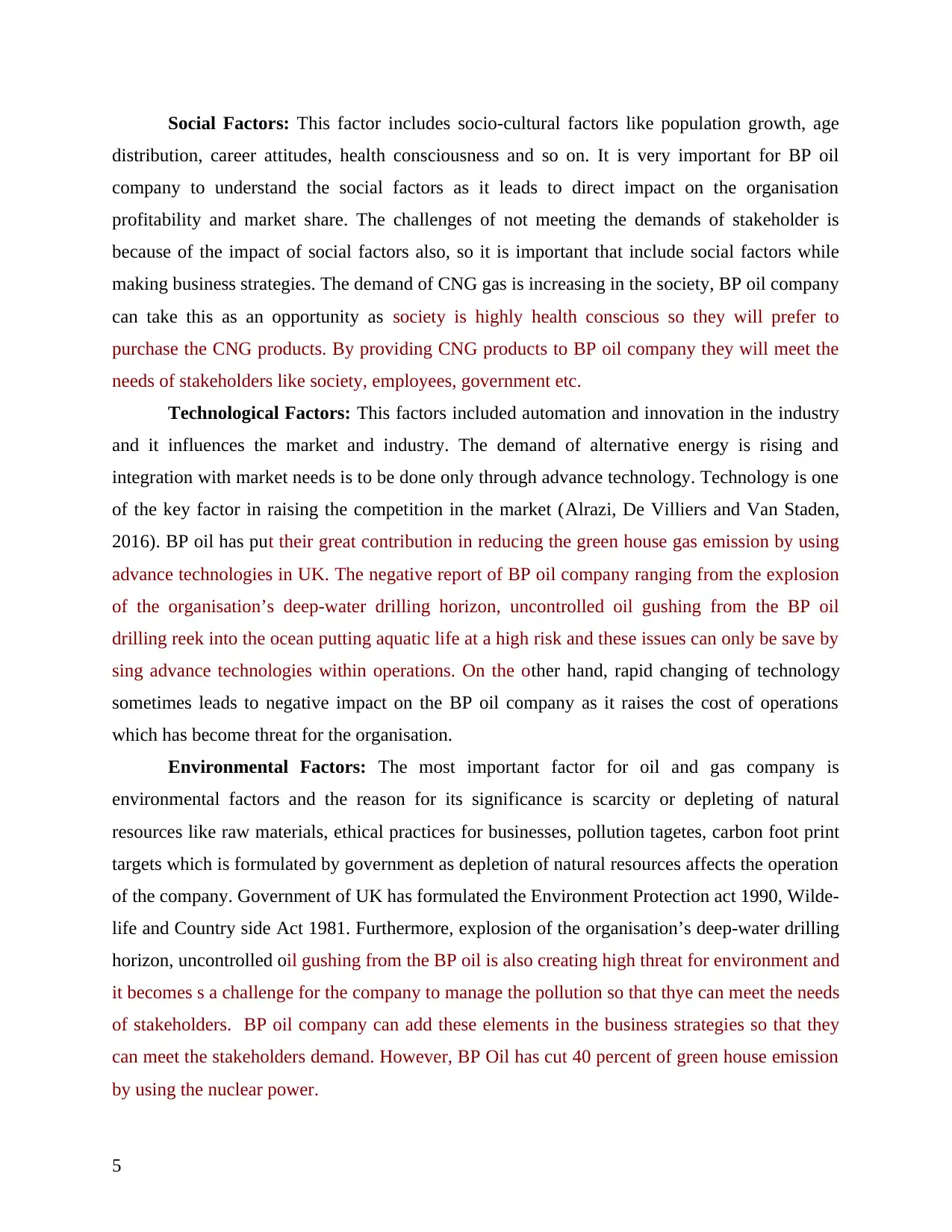
Social Factors: This factor includes socio-cultural factors like population growth, age
distribution, career attitudes, health consciousness and so on. It is very important for BP oil
company to understand the social factors as it leads to direct impact on the organisation
profitability and market share. The challenges of not meeting the demands of stakeholder is
because of the impact of social factors also, so it is important that include social factors while
making business strategies. The demand of CNG gas is increasing in the society, BP oil company
can take this as an opportunity as society is highly health conscious so they will prefer to
purchase the CNG products. By providing CNG products to BP oil company they will meet the
needs of stakeholders like society, employees, government etc.
Technological Factors: This factors included automation and innovation in the industry
and it influences the market and industry. The demand of alternative energy is rising and
integration with market needs is to be done only through advance technology. Technology is one
of the key factor in raising the competition in the market (Alrazi, De Villiers and Van Staden,
2016). BP oil has put their great contribution in reducing the green house gas emission by using
advance technologies in UK. The negative report of BP oil company ranging from the explosion
of the organisation’s deep-water drilling horizon, uncontrolled oil gushing from the BP oil
drilling reek into the ocean putting aquatic life at a high risk and these issues can only be save by
sing advance technologies within operations. On the other hand, rapid changing of technology
sometimes leads to negative impact on the BP oil company as it raises the cost of operations
which has become threat for the organisation.
Environmental Factors: The most important factor for oil and gas company is
environmental factors and the reason for its significance is scarcity or depleting of natural
resources like raw materials, ethical practices for businesses, pollution tagetes, carbon foot print
targets which is formulated by government as depletion of natural resources affects the operation
of the company. Government of UK has formulated the Environment Protection act 1990, Wilde-
life and Country side Act 1981. Furthermore, explosion of the organisation’s deep-water drilling
horizon, uncontrolled oil gushing from the BP oil is also creating high threat for environment and
it becomes s a challenge for the company to manage the pollution so that thye can meet the needs
of stakeholders. BP oil company can add these elements in the business strategies so that they
can meet the stakeholders demand. However, BP Oil has cut 40 percent of green house emission
by using the nuclear power.
5
distribution, career attitudes, health consciousness and so on. It is very important for BP oil
company to understand the social factors as it leads to direct impact on the organisation
profitability and market share. The challenges of not meeting the demands of stakeholder is
because of the impact of social factors also, so it is important that include social factors while
making business strategies. The demand of CNG gas is increasing in the society, BP oil company
can take this as an opportunity as society is highly health conscious so they will prefer to
purchase the CNG products. By providing CNG products to BP oil company they will meet the
needs of stakeholders like society, employees, government etc.
Technological Factors: This factors included automation and innovation in the industry
and it influences the market and industry. The demand of alternative energy is rising and
integration with market needs is to be done only through advance technology. Technology is one
of the key factor in raising the competition in the market (Alrazi, De Villiers and Van Staden,
2016). BP oil has put their great contribution in reducing the green house gas emission by using
advance technologies in UK. The negative report of BP oil company ranging from the explosion
of the organisation’s deep-water drilling horizon, uncontrolled oil gushing from the BP oil
drilling reek into the ocean putting aquatic life at a high risk and these issues can only be save by
sing advance technologies within operations. On the other hand, rapid changing of technology
sometimes leads to negative impact on the BP oil company as it raises the cost of operations
which has become threat for the organisation.
Environmental Factors: The most important factor for oil and gas company is
environmental factors and the reason for its significance is scarcity or depleting of natural
resources like raw materials, ethical practices for businesses, pollution tagetes, carbon foot print
targets which is formulated by government as depletion of natural resources affects the operation
of the company. Government of UK has formulated the Environment Protection act 1990, Wilde-
life and Country side Act 1981. Furthermore, explosion of the organisation’s deep-water drilling
horizon, uncontrolled oil gushing from the BP oil is also creating high threat for environment and
it becomes s a challenge for the company to manage the pollution so that thye can meet the needs
of stakeholders. BP oil company can add these elements in the business strategies so that they
can meet the stakeholders demand. However, BP Oil has cut 40 percent of green house emission
by using the nuclear power.
5

Legal Factors: This factor includes all the laws and regulations to conduct the
operations. UK government is highly concern about the policies regarding health and safety. At
the same time, government of UK is highly concerned for the employees of oil and gas
companies because they are working in highly dangerous department like drilling of oil and
petroleum, exploration and disposal. Employees are key stakeholders of BP oil company, so
company should add for employees sake to make them satisfied (Hamilton and Webster, 2018).
If BP oil company do not follow the laws and regulations than it will create threat for the
organisation as it directly impact in the image of the company and sometimes it leads to seas of
the businesses. But on the other hand, if BP oil follow the laws and regulation it will create
opportunity to raise the corporate image.
From the above external analysis, it has been understood that factors of macro
environment is rendering both positive and negative impact on the businesses that also infuces
the business decisions of BP oil company.
SWOT Analysis
STRENGTH
Strong International Presence
BP has number of retail brands and
subsidiaries like ARCO, BP Express,
BP Connect and any other that provides
diversified revenue.
Highly Skilled Workers (Crystal,
2016).
WEAKNESSES
Dissatisfied Stakeholders of BP oil
company as key workers are leaving
their jobs.
Employee Turnover is getting high
because of decreasing reputation.
Long term debt is increasing.
Petrol pricing are increasing in UK
(Wadud, 2016).
OPPORTUNITIES
Have Potential to become market
leaders through organic or alternative
energy and fuel market (Ottman, 2017).
Business expansion in new
geographical area.
Could launch easy prices to customers
THREAT
Environmental issues are very high.
Threat of global carbon foot print
emission.
Threat of high competition from
Chevron and Shell (Begum and Pereira,
6
operations. UK government is highly concern about the policies regarding health and safety. At
the same time, government of UK is highly concerned for the employees of oil and gas
companies because they are working in highly dangerous department like drilling of oil and
petroleum, exploration and disposal. Employees are key stakeholders of BP oil company, so
company should add for employees sake to make them satisfied (Hamilton and Webster, 2018).
If BP oil company do not follow the laws and regulations than it will create threat for the
organisation as it directly impact in the image of the company and sometimes it leads to seas of
the businesses. But on the other hand, if BP oil follow the laws and regulation it will create
opportunity to raise the corporate image.
From the above external analysis, it has been understood that factors of macro
environment is rendering both positive and negative impact on the businesses that also infuces
the business decisions of BP oil company.
SWOT Analysis
STRENGTH
Strong International Presence
BP has number of retail brands and
subsidiaries like ARCO, BP Express,
BP Connect and any other that provides
diversified revenue.
Highly Skilled Workers (Crystal,
2016).
WEAKNESSES
Dissatisfied Stakeholders of BP oil
company as key workers are leaving
their jobs.
Employee Turnover is getting high
because of decreasing reputation.
Long term debt is increasing.
Petrol pricing are increasing in UK
(Wadud, 2016).
OPPORTUNITIES
Have Potential to become market
leaders through organic or alternative
energy and fuel market (Ottman, 2017).
Business expansion in new
geographical area.
Could launch easy prices to customers
THREAT
Environmental issues are very high.
Threat of global carbon foot print
emission.
Threat of high competition from
Chevron and Shell (Begum and Pereira,
6
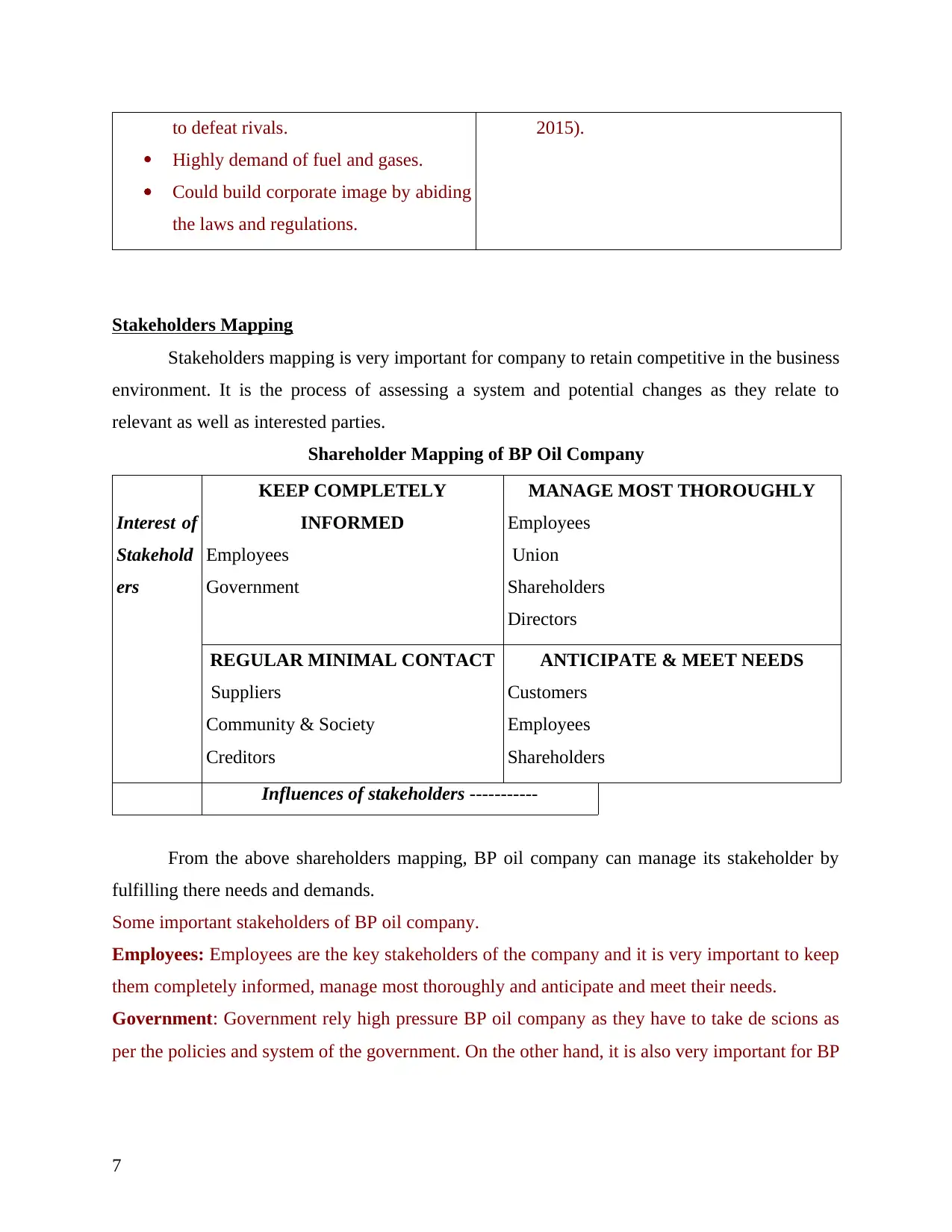
to defeat rivals.
Highly demand of fuel and gases.
Could build corporate image by abiding
the laws and regulations.
2015).
Stakeholders Mapping
Stakeholders mapping is very important for company to retain competitive in the business
environment. It is the process of assessing a system and potential changes as they relate to
relevant as well as interested parties.
Shareholder Mapping of BP Oil Company
Interest of
Stakehold
ers
KEEP COMPLETELY
INFORMED
Employees
Government
MANAGE MOST THOROUGHLY
Employees
Union
Shareholders
Directors
REGULAR MINIMAL CONTACT
Suppliers
Community & Society
Creditors
ANTICIPATE & MEET NEEDS
Customers
Employees
Shareholders
Influences of stakeholders -----------
From the above shareholders mapping, BP oil company can manage its stakeholder by
fulfilling there needs and demands.
Some important stakeholders of BP oil company.
Employees: Employees are the key stakeholders of the company and it is very important to keep
them completely informed, manage most thoroughly and anticipate and meet their needs.
Government: Government rely high pressure BP oil company as they have to take de scions as
per the policies and system of the government. On the other hand, it is also very important for BP
7
Highly demand of fuel and gases.
Could build corporate image by abiding
the laws and regulations.
2015).
Stakeholders Mapping
Stakeholders mapping is very important for company to retain competitive in the business
environment. It is the process of assessing a system and potential changes as they relate to
relevant as well as interested parties.
Shareholder Mapping of BP Oil Company
Interest of
Stakehold
ers
KEEP COMPLETELY
INFORMED
Employees
Government
MANAGE MOST THOROUGHLY
Employees
Union
Shareholders
Directors
REGULAR MINIMAL CONTACT
Suppliers
Community & Society
Creditors
ANTICIPATE & MEET NEEDS
Customers
Employees
Shareholders
Influences of stakeholders -----------
From the above shareholders mapping, BP oil company can manage its stakeholder by
fulfilling there needs and demands.
Some important stakeholders of BP oil company.
Employees: Employees are the key stakeholders of the company and it is very important to keep
them completely informed, manage most thoroughly and anticipate and meet their needs.
Government: Government rely high pressure BP oil company as they have to take de scions as
per the policies and system of the government. On the other hand, it is also very important for BP
7
Paraphrase This Document
Need a fresh take? Get an instant paraphrase of this document with our AI Paraphraser
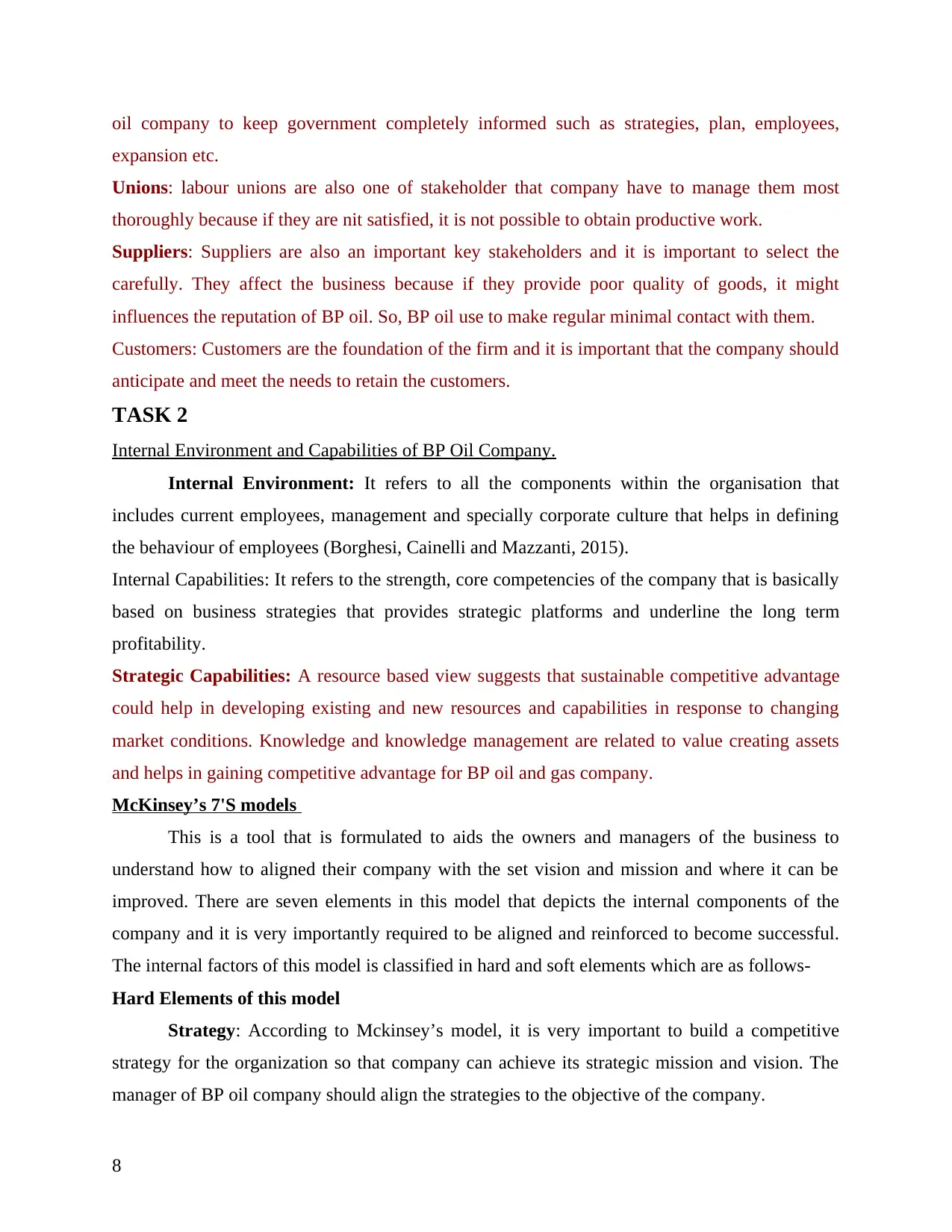
oil company to keep government completely informed such as strategies, plan, employees,
expansion etc.
Unions: labour unions are also one of stakeholder that company have to manage them most
thoroughly because if they are nit satisfied, it is not possible to obtain productive work.
Suppliers: Suppliers are also an important key stakeholders and it is important to select the
carefully. They affect the business because if they provide poor quality of goods, it might
influences the reputation of BP oil. So, BP oil use to make regular minimal contact with them.
Customers: Customers are the foundation of the firm and it is important that the company should
anticipate and meet the needs to retain the customers.
TASK 2
Internal Environment and Capabilities of BP Oil Company.
Internal Environment: It refers to all the components within the organisation that
includes current employees, management and specially corporate culture that helps in defining
the behaviour of employees (Borghesi, Cainelli and Mazzanti, 2015).
Internal Capabilities: It refers to the strength, core competencies of the company that is basically
based on business strategies that provides strategic platforms and underline the long term
profitability.
Strategic Capabilities: A resource based view suggests that sustainable competitive advantage
could help in developing existing and new resources and capabilities in response to changing
market conditions. Knowledge and knowledge management are related to value creating assets
and helps in gaining competitive advantage for BP oil and gas company.
McKinsey’s 7'S models
This is a tool that is formulated to aids the owners and managers of the business to
understand how to aligned their company with the set vision and mission and where it can be
improved. There are seven elements in this model that depicts the internal components of the
company and it is very importantly required to be aligned and reinforced to become successful.
The internal factors of this model is classified in hard and soft elements which are as follows-
Hard Elements of this model
Strategy: According to Mckinsey’s model, it is very important to build a competitive
strategy for the organization so that company can achieve its strategic mission and vision. The
manager of BP oil company should align the strategies to the objective of the company.
8
expansion etc.
Unions: labour unions are also one of stakeholder that company have to manage them most
thoroughly because if they are nit satisfied, it is not possible to obtain productive work.
Suppliers: Suppliers are also an important key stakeholders and it is important to select the
carefully. They affect the business because if they provide poor quality of goods, it might
influences the reputation of BP oil. So, BP oil use to make regular minimal contact with them.
Customers: Customers are the foundation of the firm and it is important that the company should
anticipate and meet the needs to retain the customers.
TASK 2
Internal Environment and Capabilities of BP Oil Company.
Internal Environment: It refers to all the components within the organisation that
includes current employees, management and specially corporate culture that helps in defining
the behaviour of employees (Borghesi, Cainelli and Mazzanti, 2015).
Internal Capabilities: It refers to the strength, core competencies of the company that is basically
based on business strategies that provides strategic platforms and underline the long term
profitability.
Strategic Capabilities: A resource based view suggests that sustainable competitive advantage
could help in developing existing and new resources and capabilities in response to changing
market conditions. Knowledge and knowledge management are related to value creating assets
and helps in gaining competitive advantage for BP oil and gas company.
McKinsey’s 7'S models
This is a tool that is formulated to aids the owners and managers of the business to
understand how to aligned their company with the set vision and mission and where it can be
improved. There are seven elements in this model that depicts the internal components of the
company and it is very importantly required to be aligned and reinforced to become successful.
The internal factors of this model is classified in hard and soft elements which are as follows-
Hard Elements of this model
Strategy: According to Mckinsey’s model, it is very important to build a competitive
strategy for the organization so that company can achieve its strategic mission and vision. The
manager of BP oil company should align the strategies to the objective of the company.
8
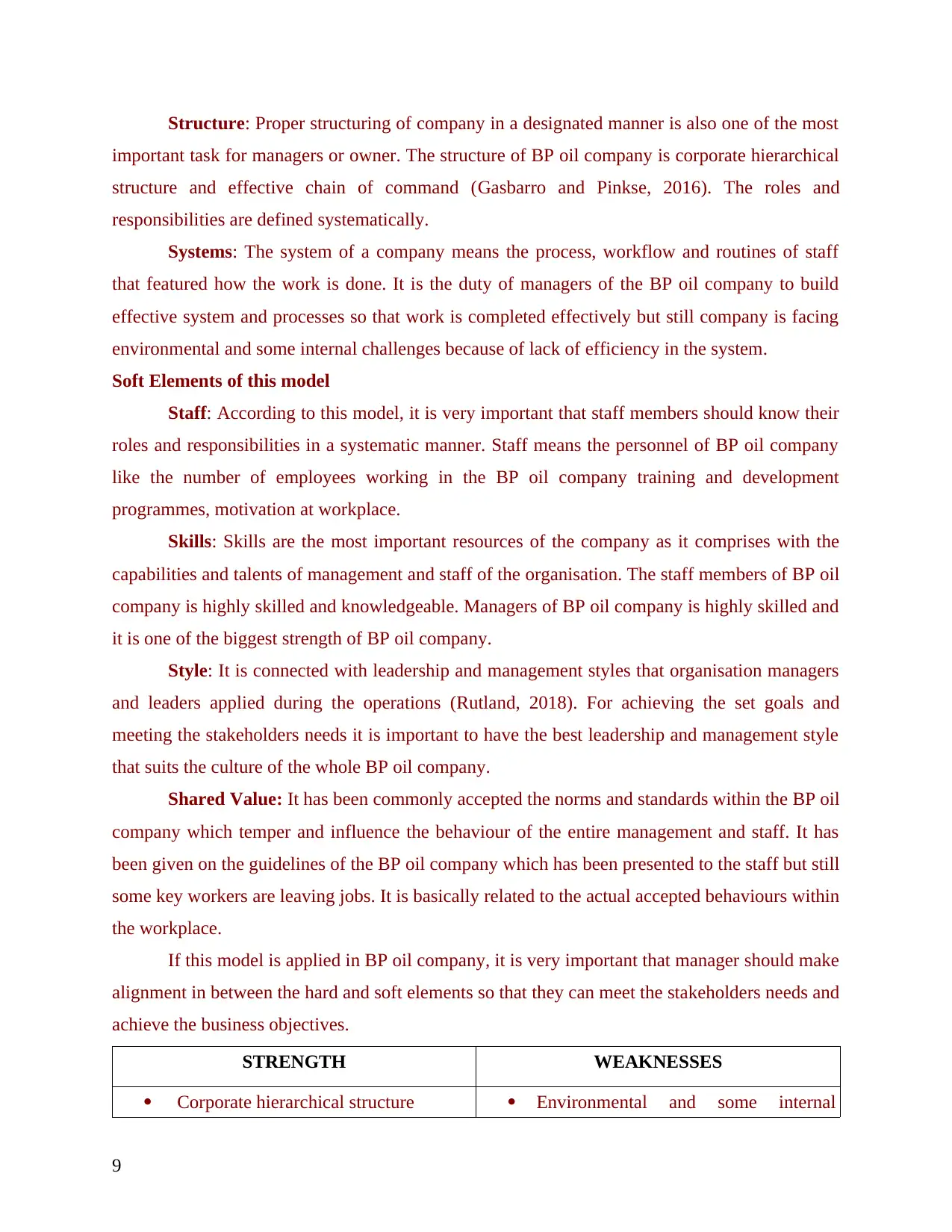
Structure: Proper structuring of company in a designated manner is also one of the most
important task for managers or owner. The structure of BP oil company is corporate hierarchical
structure and effective chain of command (Gasbarro and Pinkse, 2016). The roles and
responsibilities are defined systematically.
Systems: The system of a company means the process, workflow and routines of staff
that featured how the work is done. It is the duty of managers of the BP oil company to build
effective system and processes so that work is completed effectively but still company is facing
environmental and some internal challenges because of lack of efficiency in the system.
Soft Elements of this model
Staff: According to this model, it is very important that staff members should know their
roles and responsibilities in a systematic manner. Staff means the personnel of BP oil company
like the number of employees working in the BP oil company training and development
programmes, motivation at workplace.
Skills: Skills are the most important resources of the company as it comprises with the
capabilities and talents of management and staff of the organisation. The staff members of BP oil
company is highly skilled and knowledgeable. Managers of BP oil company is highly skilled and
it is one of the biggest strength of BP oil company.
Style: It is connected with leadership and management styles that organisation managers
and leaders applied during the operations (Rutland, 2018). For achieving the set goals and
meeting the stakeholders needs it is important to have the best leadership and management style
that suits the culture of the whole BP oil company.
Shared Value: It has been commonly accepted the norms and standards within the BP oil
company which temper and influence the behaviour of the entire management and staff. It has
been given on the guidelines of the BP oil company which has been presented to the staff but still
some key workers are leaving jobs. It is basically related to the actual accepted behaviours within
the workplace.
If this model is applied in BP oil company, it is very important that manager should make
alignment in between the hard and soft elements so that they can meet the stakeholders needs and
achieve the business objectives.
STRENGTH WEAKNESSES
Corporate hierarchical structure Environmental and some internal
9
important task for managers or owner. The structure of BP oil company is corporate hierarchical
structure and effective chain of command (Gasbarro and Pinkse, 2016). The roles and
responsibilities are defined systematically.
Systems: The system of a company means the process, workflow and routines of staff
that featured how the work is done. It is the duty of managers of the BP oil company to build
effective system and processes so that work is completed effectively but still company is facing
environmental and some internal challenges because of lack of efficiency in the system.
Soft Elements of this model
Staff: According to this model, it is very important that staff members should know their
roles and responsibilities in a systematic manner. Staff means the personnel of BP oil company
like the number of employees working in the BP oil company training and development
programmes, motivation at workplace.
Skills: Skills are the most important resources of the company as it comprises with the
capabilities and talents of management and staff of the organisation. The staff members of BP oil
company is highly skilled and knowledgeable. Managers of BP oil company is highly skilled and
it is one of the biggest strength of BP oil company.
Style: It is connected with leadership and management styles that organisation managers
and leaders applied during the operations (Rutland, 2018). For achieving the set goals and
meeting the stakeholders needs it is important to have the best leadership and management style
that suits the culture of the whole BP oil company.
Shared Value: It has been commonly accepted the norms and standards within the BP oil
company which temper and influence the behaviour of the entire management and staff. It has
been given on the guidelines of the BP oil company which has been presented to the staff but still
some key workers are leaving jobs. It is basically related to the actual accepted behaviours within
the workplace.
If this model is applied in BP oil company, it is very important that manager should make
alignment in between the hard and soft elements so that they can meet the stakeholders needs and
achieve the business objectives.
STRENGTH WEAKNESSES
Corporate hierarchical structure Environmental and some internal
9
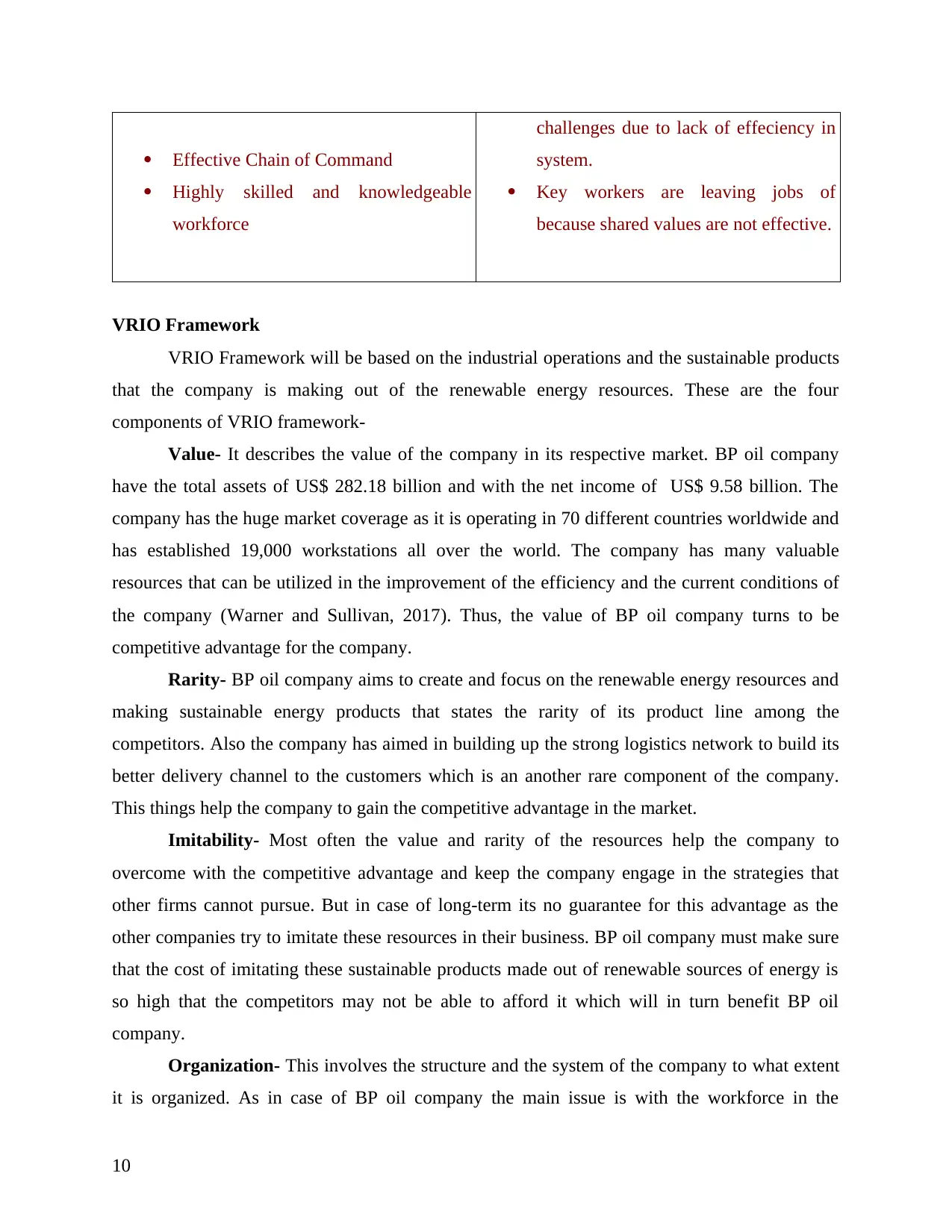
Effective Chain of Command
Highly skilled and knowledgeable
workforce
challenges due to lack of effeciency in
system.
Key workers are leaving jobs of
because shared values are not effective.
VRIO Framework
VRIO Framework will be based on the industrial operations and the sustainable products
that the company is making out of the renewable energy resources. These are the four
components of VRIO framework-
Value- It describes the value of the company in its respective market. BP oil company
have the total assets of US$ 282.18 billion and with the net income of US$ 9.58 billion. The
company has the huge market coverage as it is operating in 70 different countries worldwide and
has established 19,000 workstations all over the world. The company has many valuable
resources that can be utilized in the improvement of the efficiency and the current conditions of
the company (Warner and Sullivan, 2017). Thus, the value of BP oil company turns to be
competitive advantage for the company.
Rarity- BP oil company aims to create and focus on the renewable energy resources and
making sustainable energy products that states the rarity of its product line among the
competitors. Also the company has aimed in building up the strong logistics network to build its
better delivery channel to the customers which is an another rare component of the company.
This things help the company to gain the competitive advantage in the market.
Imitability- Most often the value and rarity of the resources help the company to
overcome with the competitive advantage and keep the company engage in the strategies that
other firms cannot pursue. But in case of long-term its no guarantee for this advantage as the
other companies try to imitate these resources in their business. BP oil company must make sure
that the cost of imitating these sustainable products made out of renewable sources of energy is
so high that the competitors may not be able to afford it which will in turn benefit BP oil
company.
Organization- This involves the structure and the system of the company to what extent
it is organized. As in case of BP oil company the main issue is with the workforce in the
10
Highly skilled and knowledgeable
workforce
challenges due to lack of effeciency in
system.
Key workers are leaving jobs of
because shared values are not effective.
VRIO Framework
VRIO Framework will be based on the industrial operations and the sustainable products
that the company is making out of the renewable energy resources. These are the four
components of VRIO framework-
Value- It describes the value of the company in its respective market. BP oil company
have the total assets of US$ 282.18 billion and with the net income of US$ 9.58 billion. The
company has the huge market coverage as it is operating in 70 different countries worldwide and
has established 19,000 workstations all over the world. The company has many valuable
resources that can be utilized in the improvement of the efficiency and the current conditions of
the company (Warner and Sullivan, 2017). Thus, the value of BP oil company turns to be
competitive advantage for the company.
Rarity- BP oil company aims to create and focus on the renewable energy resources and
making sustainable energy products that states the rarity of its product line among the
competitors. Also the company has aimed in building up the strong logistics network to build its
better delivery channel to the customers which is an another rare component of the company.
This things help the company to gain the competitive advantage in the market.
Imitability- Most often the value and rarity of the resources help the company to
overcome with the competitive advantage and keep the company engage in the strategies that
other firms cannot pursue. But in case of long-term its no guarantee for this advantage as the
other companies try to imitate these resources in their business. BP oil company must make sure
that the cost of imitating these sustainable products made out of renewable sources of energy is
so high that the competitors may not be able to afford it which will in turn benefit BP oil
company.
Organization- This involves the structure and the system of the company to what extent
it is organized. As in case of BP oil company the main issue is with the workforce in the
10
Secure Best Marks with AI Grader
Need help grading? Try our AI Grader for instant feedback on your assignments.

company as the key workers of the company are being shifted in its competitors firms. This has
cause the decline in the production efficiency as well as increased the chances of risk and loss
over the time (Post, Rahman and McQuillen, 2015). BP oil company has to find out the cause for
this issue and also find out the immediate solution for it. The company has to frame different
strategies to achieve the primary objective of the firm and survive in the market through beating
up its competitors.
TASK 3
Evaluating the competitive forces that influences the BP Oil Company.
Firm deals in various petrochemical products along with regular reforms are being
undertaken by the professionals in accordance with analysing the profitability of the product line
which would be beneficial in attracting the large number of buyers. The fuel efficiency and
mileage would result in generating consumers.
Porter's Five Force's to evaluate the competitive forces.
Porter's five forces is one of the best model that helps in determining the level of
competition in the market as well as other external forces that impact ion the entire functions and
operations of the organizations. There are mainly five elements in this model which are as
follows-
Threat of Competition: The threat of competition is very high in oil and gas company.
There are major players operating in the market that includes Total, Shell, Texaco, Gilf Coast,
Petro China, OMP and many more players operating in the industry. There are many factors on
which all the players compete from each other such as product differentiation, economies of
scale and variable and fixed cost (Buckley and et.al., 2016). Thus, in order to over the threat of
competition, BP oil company have started moving towards merger will small firms to have
competitive edge over its rivalries.
Thereat of New Entrants:The threat of new entrants is relatively low in oil and gas
company, it is because of high infrastructure, high cost of operations and extreme challenges in
operating the company. Moreover, it is not easy for any organisations or a person to set up the
entire organisation.
Threat of Substitutes: The threat of substitutes is moderate in the oil and gas industry
and the forces influences the BP oil company as well. There are some products like biofuels and
11
cause the decline in the production efficiency as well as increased the chances of risk and loss
over the time (Post, Rahman and McQuillen, 2015). BP oil company has to find out the cause for
this issue and also find out the immediate solution for it. The company has to frame different
strategies to achieve the primary objective of the firm and survive in the market through beating
up its competitors.
TASK 3
Evaluating the competitive forces that influences the BP Oil Company.
Firm deals in various petrochemical products along with regular reforms are being
undertaken by the professionals in accordance with analysing the profitability of the product line
which would be beneficial in attracting the large number of buyers. The fuel efficiency and
mileage would result in generating consumers.
Porter's Five Force's to evaluate the competitive forces.
Porter's five forces is one of the best model that helps in determining the level of
competition in the market as well as other external forces that impact ion the entire functions and
operations of the organizations. There are mainly five elements in this model which are as
follows-
Threat of Competition: The threat of competition is very high in oil and gas company.
There are major players operating in the market that includes Total, Shell, Texaco, Gilf Coast,
Petro China, OMP and many more players operating in the industry. There are many factors on
which all the players compete from each other such as product differentiation, economies of
scale and variable and fixed cost (Buckley and et.al., 2016). Thus, in order to over the threat of
competition, BP oil company have started moving towards merger will small firms to have
competitive edge over its rivalries.
Thereat of New Entrants:The threat of new entrants is relatively low in oil and gas
company, it is because of high infrastructure, high cost of operations and extreme challenges in
operating the company. Moreover, it is not easy for any organisations or a person to set up the
entire organisation.
Threat of Substitutes: The threat of substitutes is moderate in the oil and gas industry
and the forces influences the BP oil company as well. There are some products like biofuels and
11
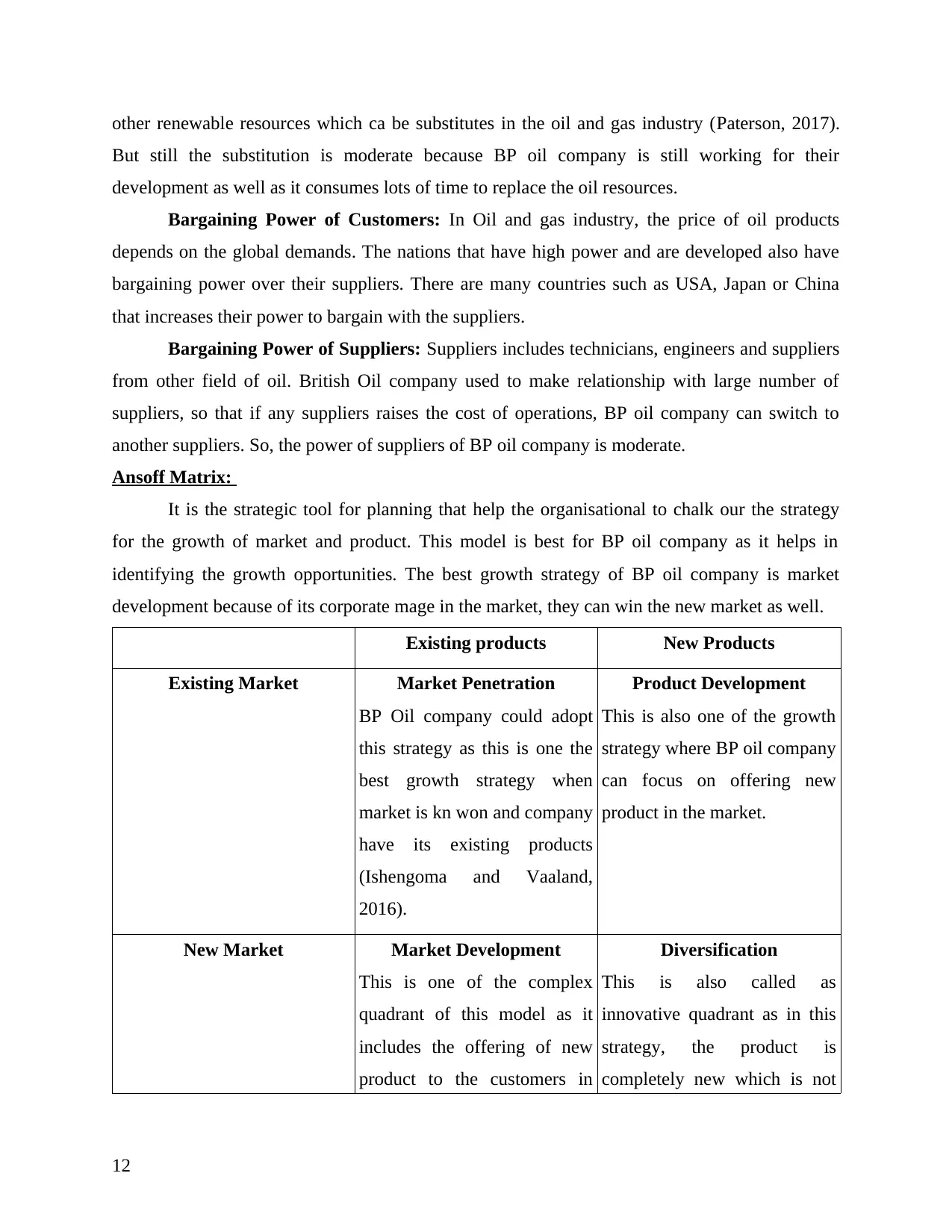
other renewable resources which ca be substitutes in the oil and gas industry (Paterson, 2017).
But still the substitution is moderate because BP oil company is still working for their
development as well as it consumes lots of time to replace the oil resources.
Bargaining Power of Customers: In Oil and gas industry, the price of oil products
depends on the global demands. The nations that have high power and are developed also have
bargaining power over their suppliers. There are many countries such as USA, Japan or China
that increases their power to bargain with the suppliers.
Bargaining Power of Suppliers: Suppliers includes technicians, engineers and suppliers
from other field of oil. British Oil company used to make relationship with large number of
suppliers, so that if any suppliers raises the cost of operations, BP oil company can switch to
another suppliers. So, the power of suppliers of BP oil company is moderate.
Ansoff Matrix:
It is the strategic tool for planning that help the organisational to chalk our the strategy
for the growth of market and product. This model is best for BP oil company as it helps in
identifying the growth opportunities. The best growth strategy of BP oil company is market
development because of its corporate mage in the market, they can win the new market as well.
Existing products New Products
Existing Market Market Penetration
BP Oil company could adopt
this strategy as this is one the
best growth strategy when
market is kn won and company
have its existing products
(Ishengoma and Vaaland,
2016).
Product Development
This is also one of the growth
strategy where BP oil company
can focus on offering new
product in the market.
New Market Market Development
This is one of the complex
quadrant of this model as it
includes the offering of new
product to the customers in
Diversification
This is also called as
innovative quadrant as in this
strategy, the product is
completely new which is not
12
But still the substitution is moderate because BP oil company is still working for their
development as well as it consumes lots of time to replace the oil resources.
Bargaining Power of Customers: In Oil and gas industry, the price of oil products
depends on the global demands. The nations that have high power and are developed also have
bargaining power over their suppliers. There are many countries such as USA, Japan or China
that increases their power to bargain with the suppliers.
Bargaining Power of Suppliers: Suppliers includes technicians, engineers and suppliers
from other field of oil. British Oil company used to make relationship with large number of
suppliers, so that if any suppliers raises the cost of operations, BP oil company can switch to
another suppliers. So, the power of suppliers of BP oil company is moderate.
Ansoff Matrix:
It is the strategic tool for planning that help the organisational to chalk our the strategy
for the growth of market and product. This model is best for BP oil company as it helps in
identifying the growth opportunities. The best growth strategy of BP oil company is market
development because of its corporate mage in the market, they can win the new market as well.
Existing products New Products
Existing Market Market Penetration
BP Oil company could adopt
this strategy as this is one the
best growth strategy when
market is kn won and company
have its existing products
(Ishengoma and Vaaland,
2016).
Product Development
This is also one of the growth
strategy where BP oil company
can focus on offering new
product in the market.
New Market Market Development
This is one of the complex
quadrant of this model as it
includes the offering of new
product to the customers in
Diversification
This is also called as
innovative quadrant as in this
strategy, the product is
completely new which is not
12
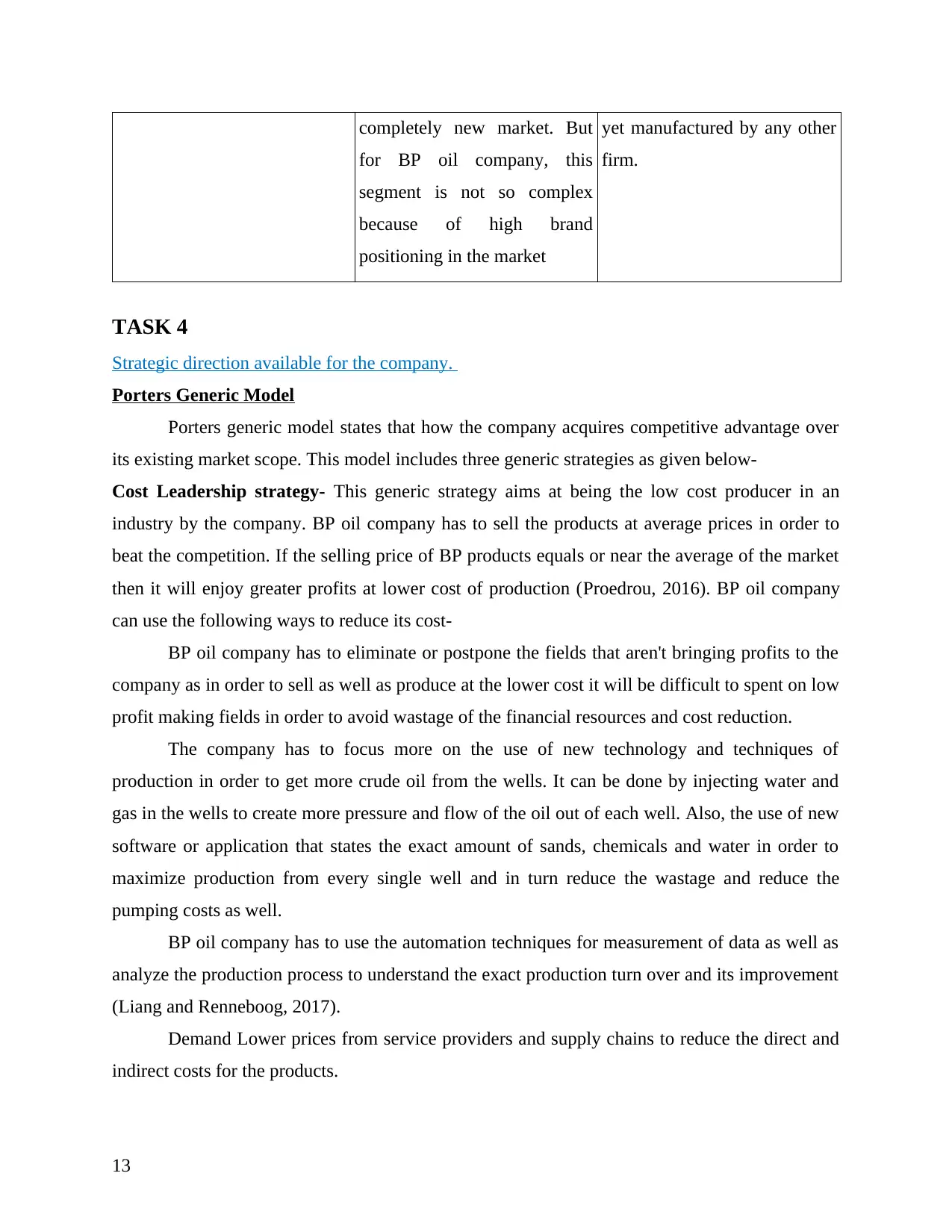
completely new market. But
for BP oil company, this
segment is not so complex
because of high brand
positioning in the market
yet manufactured by any other
firm.
TASK 4
Strategic direction available for the company.
Porters Generic Model
Porters generic model states that how the company acquires competitive advantage over
its existing market scope. This model includes three generic strategies as given below-
Cost Leadership strategy- This generic strategy aims at being the low cost producer in an
industry by the company. BP oil company has to sell the products at average prices in order to
beat the competition. If the selling price of BP products equals or near the average of the market
then it will enjoy greater profits at lower cost of production (Proedrou, 2016). BP oil company
can use the following ways to reduce its cost-
BP oil company has to eliminate or postpone the fields that aren't bringing profits to the
company as in order to sell as well as produce at the lower cost it will be difficult to spent on low
profit making fields in order to avoid wastage of the financial resources and cost reduction.
The company has to focus more on the use of new technology and techniques of
production in order to get more crude oil from the wells. It can be done by injecting water and
gas in the wells to create more pressure and flow of the oil out of each well. Also, the use of new
software or application that states the exact amount of sands, chemicals and water in order to
maximize production from every single well and in turn reduce the wastage and reduce the
pumping costs as well.
BP oil company has to use the automation techniques for measurement of data as well as
analyze the production process to understand the exact production turn over and its improvement
(Liang and Renneboog, 2017).
Demand Lower prices from service providers and supply chains to reduce the direct and
indirect costs for the products.
13
for BP oil company, this
segment is not so complex
because of high brand
positioning in the market
yet manufactured by any other
firm.
TASK 4
Strategic direction available for the company.
Porters Generic Model
Porters generic model states that how the company acquires competitive advantage over
its existing market scope. This model includes three generic strategies as given below-
Cost Leadership strategy- This generic strategy aims at being the low cost producer in an
industry by the company. BP oil company has to sell the products at average prices in order to
beat the competition. If the selling price of BP products equals or near the average of the market
then it will enjoy greater profits at lower cost of production (Proedrou, 2016). BP oil company
can use the following ways to reduce its cost-
BP oil company has to eliminate or postpone the fields that aren't bringing profits to the
company as in order to sell as well as produce at the lower cost it will be difficult to spent on low
profit making fields in order to avoid wastage of the financial resources and cost reduction.
The company has to focus more on the use of new technology and techniques of
production in order to get more crude oil from the wells. It can be done by injecting water and
gas in the wells to create more pressure and flow of the oil out of each well. Also, the use of new
software or application that states the exact amount of sands, chemicals and water in order to
maximize production from every single well and in turn reduce the wastage and reduce the
pumping costs as well.
BP oil company has to use the automation techniques for measurement of data as well as
analyze the production process to understand the exact production turn over and its improvement
(Liang and Renneboog, 2017).
Demand Lower prices from service providers and supply chains to reduce the direct and
indirect costs for the products.
13
Paraphrase This Document
Need a fresh take? Get an instant paraphrase of this document with our AI Paraphraser
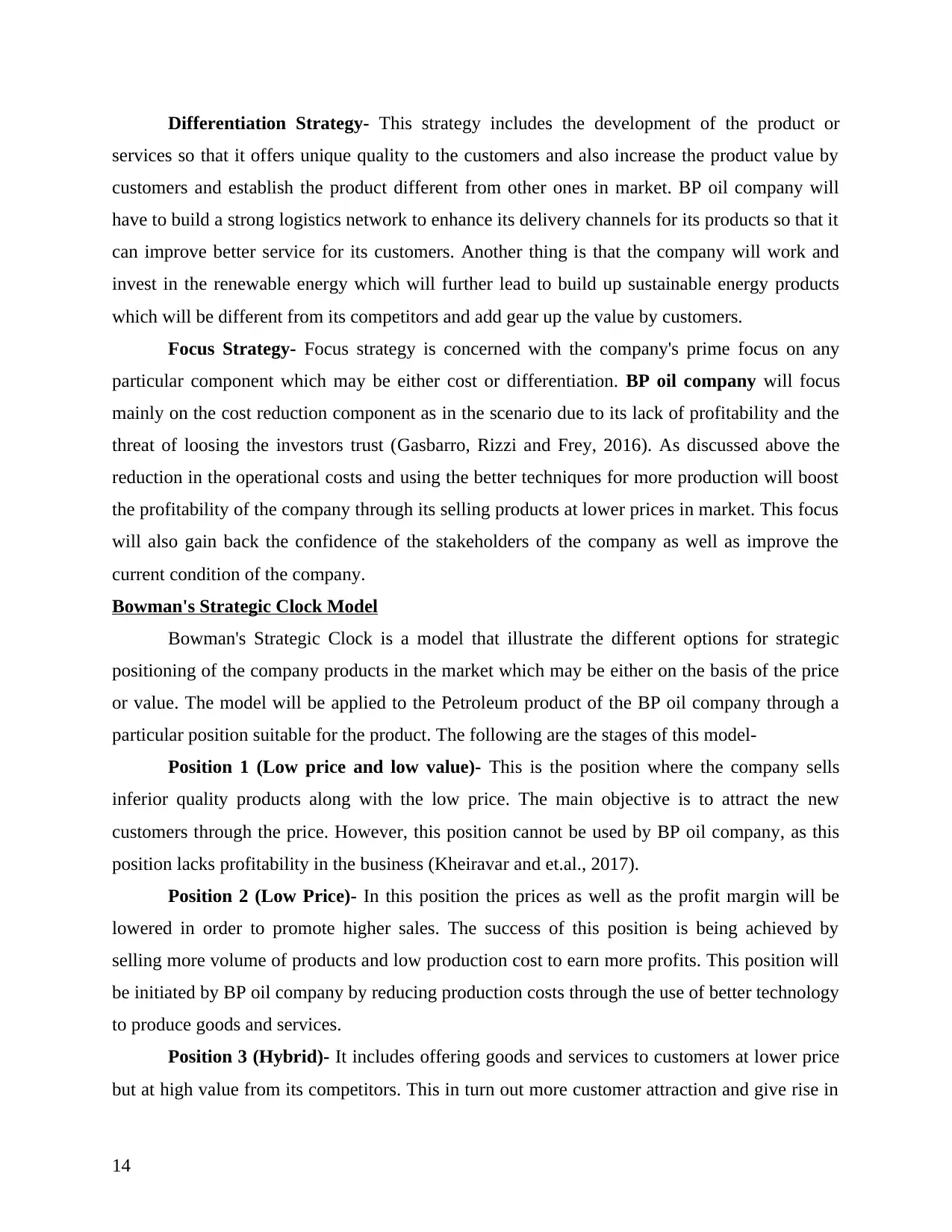
Differentiation Strategy- This strategy includes the development of the product or
services so that it offers unique quality to the customers and also increase the product value by
customers and establish the product different from other ones in market. BP oil company will
have to build a strong logistics network to enhance its delivery channels for its products so that it
can improve better service for its customers. Another thing is that the company will work and
invest in the renewable energy which will further lead to build up sustainable energy products
which will be different from its competitors and add gear up the value by customers.
Focus Strategy- Focus strategy is concerned with the company's prime focus on any
particular component which may be either cost or differentiation. BP oil company will focus
mainly on the cost reduction component as in the scenario due to its lack of profitability and the
threat of loosing the investors trust (Gasbarro, Rizzi and Frey, 2016). As discussed above the
reduction in the operational costs and using the better techniques for more production will boost
the profitability of the company through its selling products at lower prices in market. This focus
will also gain back the confidence of the stakeholders of the company as well as improve the
current condition of the company.
Bowman's Strategic Clock Model
Bowman's Strategic Clock is a model that illustrate the different options for strategic
positioning of the company products in the market which may be either on the basis of the price
or value. The model will be applied to the Petroleum product of the BP oil company through a
particular position suitable for the product. The following are the stages of this model-
Position 1 (Low price and low value)- This is the position where the company sells
inferior quality products along with the low price. The main objective is to attract the new
customers through the price. However, this position cannot be used by BP oil company, as this
position lacks profitability in the business (Kheiravar and et.al., 2017).
Position 2 (Low Price)- In this position the prices as well as the profit margin will be
lowered in order to promote higher sales. The success of this position is being achieved by
selling more volume of products and low production cost to earn more profits. This position will
be initiated by BP oil company by reducing production costs through the use of better technology
to produce goods and services.
Position 3 (Hybrid)- It includes offering goods and services to customers at lower price
but at high value from its competitors. This in turn out more customer attraction and give rise in
14
services so that it offers unique quality to the customers and also increase the product value by
customers and establish the product different from other ones in market. BP oil company will
have to build a strong logistics network to enhance its delivery channels for its products so that it
can improve better service for its customers. Another thing is that the company will work and
invest in the renewable energy which will further lead to build up sustainable energy products
which will be different from its competitors and add gear up the value by customers.
Focus Strategy- Focus strategy is concerned with the company's prime focus on any
particular component which may be either cost or differentiation. BP oil company will focus
mainly on the cost reduction component as in the scenario due to its lack of profitability and the
threat of loosing the investors trust (Gasbarro, Rizzi and Frey, 2016). As discussed above the
reduction in the operational costs and using the better techniques for more production will boost
the profitability of the company through its selling products at lower prices in market. This focus
will also gain back the confidence of the stakeholders of the company as well as improve the
current condition of the company.
Bowman's Strategic Clock Model
Bowman's Strategic Clock is a model that illustrate the different options for strategic
positioning of the company products in the market which may be either on the basis of the price
or value. The model will be applied to the Petroleum product of the BP oil company through a
particular position suitable for the product. The following are the stages of this model-
Position 1 (Low price and low value)- This is the position where the company sells
inferior quality products along with the low price. The main objective is to attract the new
customers through the price. However, this position cannot be used by BP oil company, as this
position lacks profitability in the business (Kheiravar and et.al., 2017).
Position 2 (Low Price)- In this position the prices as well as the profit margin will be
lowered in order to promote higher sales. The success of this position is being achieved by
selling more volume of products and low production cost to earn more profits. This position will
be initiated by BP oil company by reducing production costs through the use of better technology
to produce goods and services.
Position 3 (Hybrid)- It includes offering goods and services to customers at lower price
but at high value from its competitors. This in turn out more customer attraction and give rise in
14
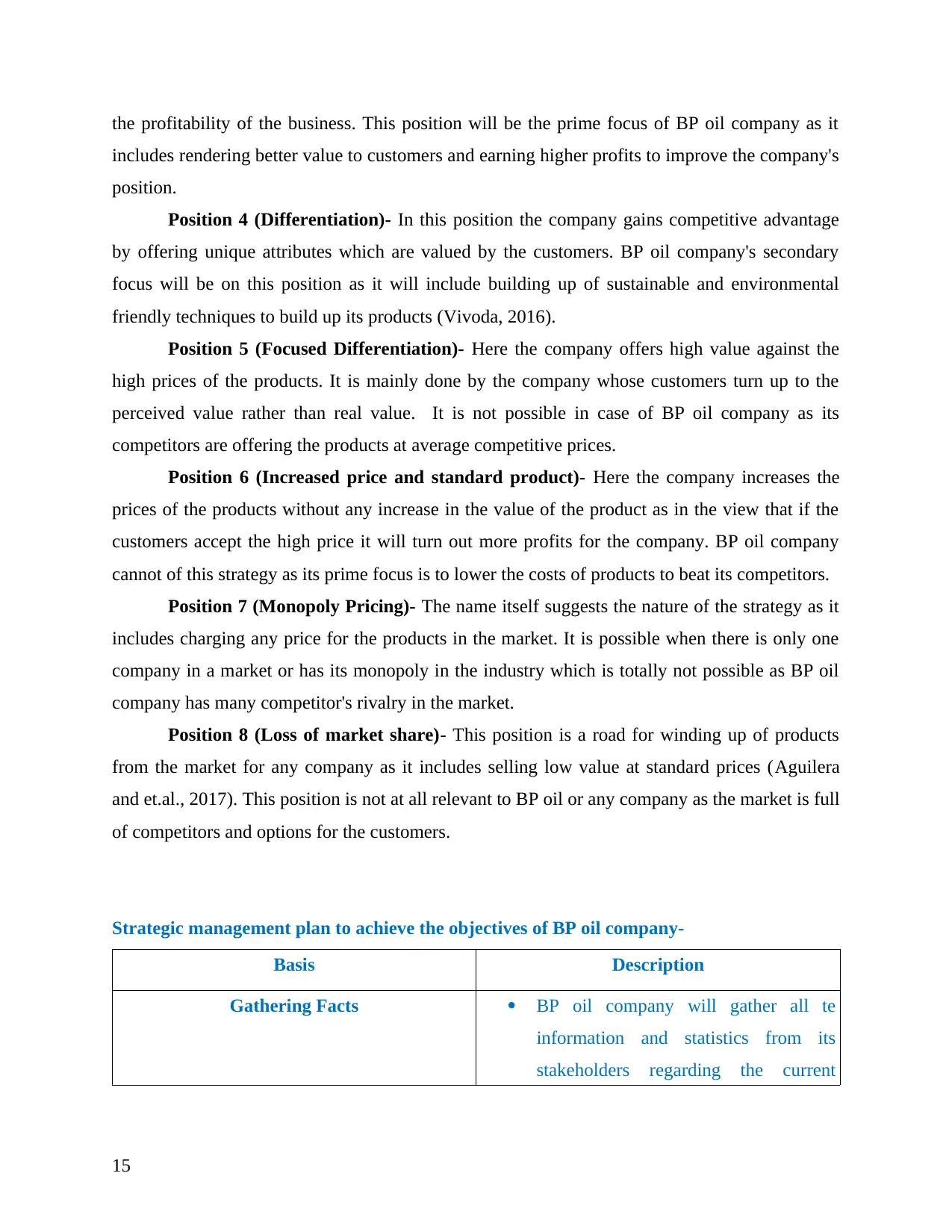
the profitability of the business. This position will be the prime focus of BP oil company as it
includes rendering better value to customers and earning higher profits to improve the company's
position.
Position 4 (Differentiation)- In this position the company gains competitive advantage
by offering unique attributes which are valued by the customers. BP oil company's secondary
focus will be on this position as it will include building up of sustainable and environmental
friendly techniques to build up its products (Vivoda, 2016).
Position 5 (Focused Differentiation)- Here the company offers high value against the
high prices of the products. It is mainly done by the company whose customers turn up to the
perceived value rather than real value. It is not possible in case of BP oil company as its
competitors are offering the products at average competitive prices.
Position 6 (Increased price and standard product)- Here the company increases the
prices of the products without any increase in the value of the product as in the view that if the
customers accept the high price it will turn out more profits for the company. BP oil company
cannot of this strategy as its prime focus is to lower the costs of products to beat its competitors.
Position 7 (Monopoly Pricing)- The name itself suggests the nature of the strategy as it
includes charging any price for the products in the market. It is possible when there is only one
company in a market or has its monopoly in the industry which is totally not possible as BP oil
company has many competitor's rivalry in the market.
Position 8 (Loss of market share)- This position is a road for winding up of products
from the market for any company as it includes selling low value at standard prices (Aguilera
and et.al., 2017). This position is not at all relevant to BP oil or any company as the market is full
of competitors and options for the customers.
Strategic management plan to achieve the objectives of BP oil company-
Basis Description
Gathering Facts BP oil company will gather all te
information and statistics from its
stakeholders regarding the current
15
includes rendering better value to customers and earning higher profits to improve the company's
position.
Position 4 (Differentiation)- In this position the company gains competitive advantage
by offering unique attributes which are valued by the customers. BP oil company's secondary
focus will be on this position as it will include building up of sustainable and environmental
friendly techniques to build up its products (Vivoda, 2016).
Position 5 (Focused Differentiation)- Here the company offers high value against the
high prices of the products. It is mainly done by the company whose customers turn up to the
perceived value rather than real value. It is not possible in case of BP oil company as its
competitors are offering the products at average competitive prices.
Position 6 (Increased price and standard product)- Here the company increases the
prices of the products without any increase in the value of the product as in the view that if the
customers accept the high price it will turn out more profits for the company. BP oil company
cannot of this strategy as its prime focus is to lower the costs of products to beat its competitors.
Position 7 (Monopoly Pricing)- The name itself suggests the nature of the strategy as it
includes charging any price for the products in the market. It is possible when there is only one
company in a market or has its monopoly in the industry which is totally not possible as BP oil
company has many competitor's rivalry in the market.
Position 8 (Loss of market share)- This position is a road for winding up of products
from the market for any company as it includes selling low value at standard prices (Aguilera
and et.al., 2017). This position is not at all relevant to BP oil or any company as the market is full
of competitors and options for the customers.
Strategic management plan to achieve the objectives of BP oil company-
Basis Description
Gathering Facts BP oil company will gather all te
information and statistics from its
stakeholders regarding the current
15
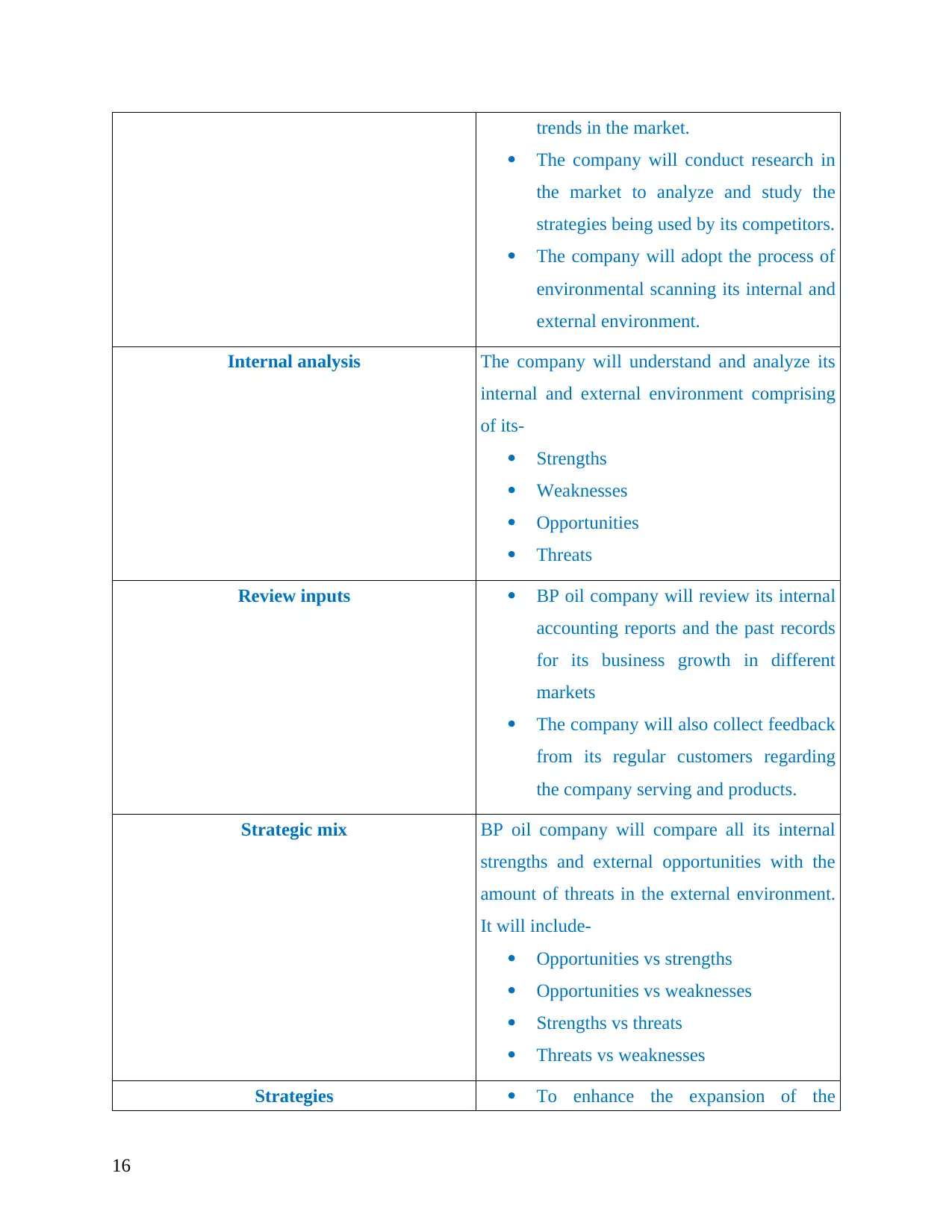
trends in the market.
The company will conduct research in
the market to analyze and study the
strategies being used by its competitors.
The company will adopt the process of
environmental scanning its internal and
external environment.
Internal analysis The company will understand and analyze its
internal and external environment comprising
of its-
Strengths
Weaknesses
Opportunities
Threats
Review inputs BP oil company will review its internal
accounting reports and the past records
for its business growth in different
markets
The company will also collect feedback
from its regular customers regarding
the company serving and products.
Strategic mix BP oil company will compare all its internal
strengths and external opportunities with the
amount of threats in the external environment.
It will include-
Opportunities vs strengths
Opportunities vs weaknesses
Strengths vs threats
Threats vs weaknesses
Strategies To enhance the expansion of the
16
The company will conduct research in
the market to analyze and study the
strategies being used by its competitors.
The company will adopt the process of
environmental scanning its internal and
external environment.
Internal analysis The company will understand and analyze its
internal and external environment comprising
of its-
Strengths
Weaknesses
Opportunities
Threats
Review inputs BP oil company will review its internal
accounting reports and the past records
for its business growth in different
markets
The company will also collect feedback
from its regular customers regarding
the company serving and products.
Strategic mix BP oil company will compare all its internal
strengths and external opportunities with the
amount of threats in the external environment.
It will include-
Opportunities vs strengths
Opportunities vs weaknesses
Strengths vs threats
Threats vs weaknesses
Strategies To enhance the expansion of the
16
Secure Best Marks with AI Grader
Need help grading? Try our AI Grader for instant feedback on your assignments.
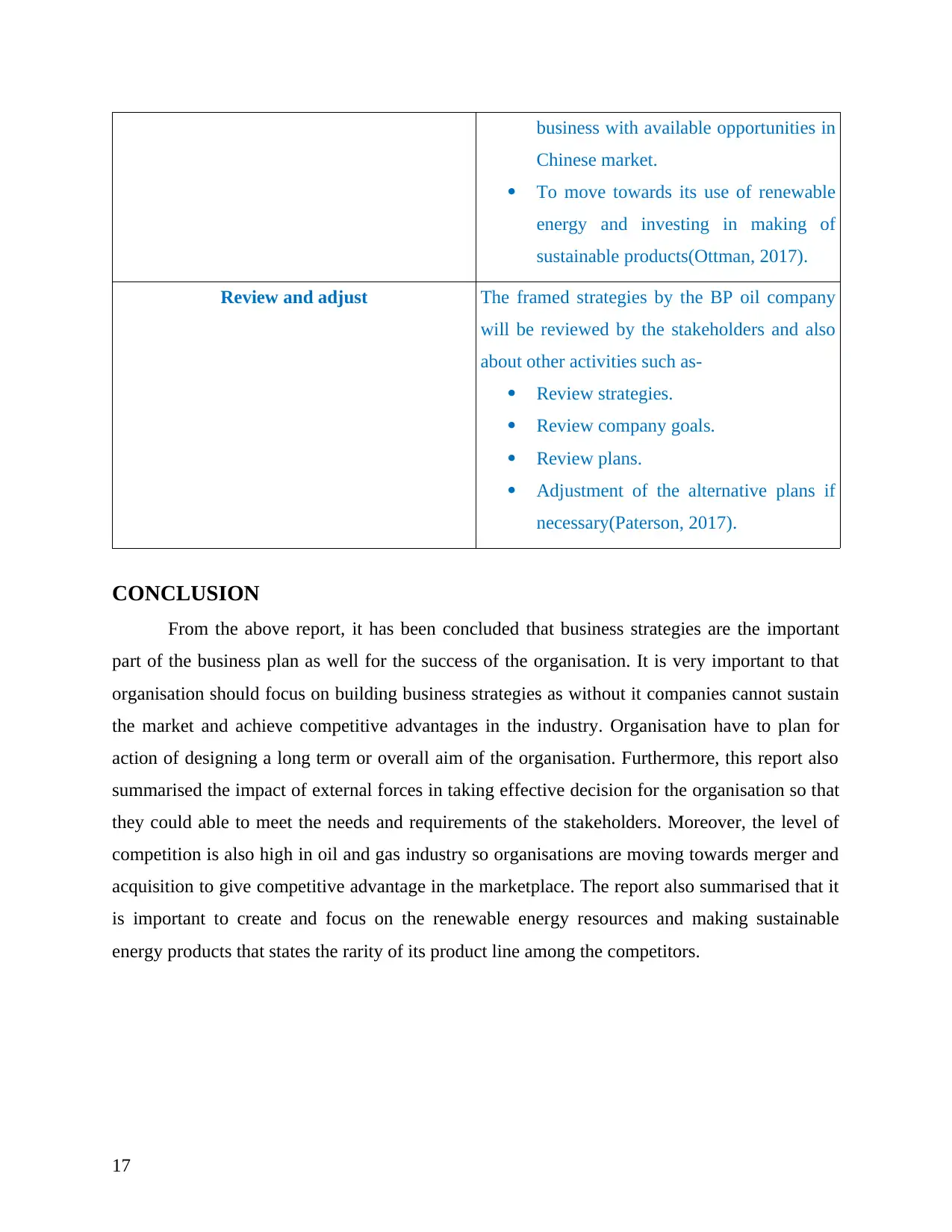
business with available opportunities in
Chinese market.
To move towards its use of renewable
energy and investing in making of
sustainable products(Ottman, 2017).
Review and adjust The framed strategies by the BP oil company
will be reviewed by the stakeholders and also
about other activities such as-
Review strategies.
Review company goals.
Review plans.
Adjustment of the alternative plans if
necessary(Paterson, 2017).
CONCLUSION
From the above report, it has been concluded that business strategies are the important
part of the business plan as well for the success of the organisation. It is very important to that
organisation should focus on building business strategies as without it companies cannot sustain
the market and achieve competitive advantages in the industry. Organisation have to plan for
action of designing a long term or overall aim of the organisation. Furthermore, this report also
summarised the impact of external forces in taking effective decision for the organisation so that
they could able to meet the needs and requirements of the stakeholders. Moreover, the level of
competition is also high in oil and gas industry so organisations are moving towards merger and
acquisition to give competitive advantage in the marketplace. The report also summarised that it
is important to create and focus on the renewable energy resources and making sustainable
energy products that states the rarity of its product line among the competitors.
17
Chinese market.
To move towards its use of renewable
energy and investing in making of
sustainable products(Ottman, 2017).
Review and adjust The framed strategies by the BP oil company
will be reviewed by the stakeholders and also
about other activities such as-
Review strategies.
Review company goals.
Review plans.
Adjustment of the alternative plans if
necessary(Paterson, 2017).
CONCLUSION
From the above report, it has been concluded that business strategies are the important
part of the business plan as well for the success of the organisation. It is very important to that
organisation should focus on building business strategies as without it companies cannot sustain
the market and achieve competitive advantages in the industry. Organisation have to plan for
action of designing a long term or overall aim of the organisation. Furthermore, this report also
summarised the impact of external forces in taking effective decision for the organisation so that
they could able to meet the needs and requirements of the stakeholders. Moreover, the level of
competition is also high in oil and gas industry so organisations are moving towards merger and
acquisition to give competitive advantage in the marketplace. The report also summarised that it
is important to create and focus on the renewable energy resources and making sustainable
energy products that states the rarity of its product line among the competitors.
17

REFERENCES
Books and Journals:
Aguilera, R.V and et.al., 2017. Multilatinas and the internationalization of Latin American
firms. Journal of World Business, 52(4), pp.447-460.
Alrazi, B., De Villiers, C. and Van Staden, C.J., 2016. The environmental disclosures of the
electricity generation industry: a global perspective. Accounting and Business
Research, 46(6), pp.665-701.
Begg, K., Van der Woerd, F. and Levy, D. eds., 2018. The business of climate change:
Corporate responses to Kyoto. Routledge.
Begum, R.A. and Pereira, J.J., 2015. The awareness, perception and motivational analysis of
climate change and business perspectives in Malaysia. Mitigation and adaptation strategies
for global change, 20(3), pp.361-370.
Borghesi, S., Cainelli, G. and Mazzanti, M., 2015. Linking emission trading to environmental
innovation: evidence from the Italian manufacturing industry. Research Policy, 44(3),
pp.669-683.
Buckley, P.J and et.al., 2016. The institutional influence on the location strategies of
multinational enterprises from emerging economies: Evidence from China's cross-border
mergers and acquisitions. Management and Organization Review, 12(3), pp.425-448.
Crystal, J., 2016. Kuwait: The transformation of an oil state. Routledge.
Feng, H., Morgan, N.A. and Rego, L.L., 2017. Firm capabilities and growth: the moderating role
of market conditions. Journal of the Academy of Marketing Science, 45(1), pp.76-92.
Gasbarro, F. and Pinkse, J., 2016. Corporate adaptation behaviour to deal with climate change:
the influence of firm‐specific interpretations of physical climate impacts. Corporate Social
Responsibility and Environmental Management, 23(3), pp.179-192.
Gasbarro, F., Rizzi, F. and Frey, M., 2016. Adaptation measures of energy and utility companies
to cope with water scarcity induced by climate change. Business Strategy and the
Environment, 25(1), pp.54-72.
Hamilton, L. and Webster, P., 2018. The international business environment. Oxford University
Press.
Ishengoma, E. and Vaaland, T.I., 2016. Can university-industry linkages stimulate student
employability?. Education+ Training, 58(1), pp.18-44.
18
Books and Journals:
Aguilera, R.V and et.al., 2017. Multilatinas and the internationalization of Latin American
firms. Journal of World Business, 52(4), pp.447-460.
Alrazi, B., De Villiers, C. and Van Staden, C.J., 2016. The environmental disclosures of the
electricity generation industry: a global perspective. Accounting and Business
Research, 46(6), pp.665-701.
Begg, K., Van der Woerd, F. and Levy, D. eds., 2018. The business of climate change:
Corporate responses to Kyoto. Routledge.
Begum, R.A. and Pereira, J.J., 2015. The awareness, perception and motivational analysis of
climate change and business perspectives in Malaysia. Mitigation and adaptation strategies
for global change, 20(3), pp.361-370.
Borghesi, S., Cainelli, G. and Mazzanti, M., 2015. Linking emission trading to environmental
innovation: evidence from the Italian manufacturing industry. Research Policy, 44(3),
pp.669-683.
Buckley, P.J and et.al., 2016. The institutional influence on the location strategies of
multinational enterprises from emerging economies: Evidence from China's cross-border
mergers and acquisitions. Management and Organization Review, 12(3), pp.425-448.
Crystal, J., 2016. Kuwait: The transformation of an oil state. Routledge.
Feng, H., Morgan, N.A. and Rego, L.L., 2017. Firm capabilities and growth: the moderating role
of market conditions. Journal of the Academy of Marketing Science, 45(1), pp.76-92.
Gasbarro, F. and Pinkse, J., 2016. Corporate adaptation behaviour to deal with climate change:
the influence of firm‐specific interpretations of physical climate impacts. Corporate Social
Responsibility and Environmental Management, 23(3), pp.179-192.
Gasbarro, F., Rizzi, F. and Frey, M., 2016. Adaptation measures of energy and utility companies
to cope with water scarcity induced by climate change. Business Strategy and the
Environment, 25(1), pp.54-72.
Hamilton, L. and Webster, P., 2018. The international business environment. Oxford University
Press.
Ishengoma, E. and Vaaland, T.I., 2016. Can university-industry linkages stimulate student
employability?. Education+ Training, 58(1), pp.18-44.
18

Kheiravar, K.H., Lawell, C.Y.L., Bushnell, J.B., Jaffe, A.M. and Muehlegger, E.J., 2017. A
structural econometric model of the dynamic game between petroleum producers in the
world petroleum market. Working paper, Cornell University.
Liang, H. and Renneboog, L., 2017. On the foundations of corporate social responsibility. The
Journal of Finance, 72(2), pp.853-910.
Lu, J. and Zhao, S., 2015. China's natural gas exploration and development strategies under the
new normal. Natural Gas Industry B, 2(6), pp.473-480.
Ottman, J., 2017. The new rules of green marketing: Strategies, tools, and inspiration for
sustainable branding. Routledge.
Paterson, J., 2017. Behind the Mask: Regulating health and safety in Britain's offshore oil and
gas industry. Routledge.
Post, C., Rahman, N. and McQuillen, C., 2015. From board composition to corporate
environmental performance through sustainability-themed alliances. Journal of Business
Ethics, 130(2), pp.423-435.
Proedrou, F., 2016. EU energy security in the gas sector: Evolving dynamics, policy dilemmas
and prospects. Routledge.
Rutland, P., 2018. Introduction: Business and the state in Russia. In Business and state in
contemporary Russia (pp. 1-32). Routledge.
Thompson, A., Strickland, A.J. and Gamble, J., 2015. Crafting and executing strategy: Concepts
and readings. McGraw-Hill Education.
Ubini, I.L., 2019. Efficient Financing, Banking, and Foreign Exchange Operations in Mitigating
Refined Petroleum Shortages in Nigerian Downstream Petroleum Supply Industry. Global
Journal of Management And Business Research.
Vivoda, V., 2016. Energy security in Japan: challenges after Fukushima. Routledge.
Wadud, Z., 2016. Diesel demand in the road freight sector in the UK: Estimates for different
vehicle types. Applied energy, 165, pp.849-857.
Warner, M. and Sullivan, R. eds., 2017. Putting partnerships to work: Strategic alliances for
development between government, the private sector and civil society. Routledge.
Online
BP Oil Company. 2019. [Online]. Available through :< https://www.bp.com/ >.
19
structural econometric model of the dynamic game between petroleum producers in the
world petroleum market. Working paper, Cornell University.
Liang, H. and Renneboog, L., 2017. On the foundations of corporate social responsibility. The
Journal of Finance, 72(2), pp.853-910.
Lu, J. and Zhao, S., 2015. China's natural gas exploration and development strategies under the
new normal. Natural Gas Industry B, 2(6), pp.473-480.
Ottman, J., 2017. The new rules of green marketing: Strategies, tools, and inspiration for
sustainable branding. Routledge.
Paterson, J., 2017. Behind the Mask: Regulating health and safety in Britain's offshore oil and
gas industry. Routledge.
Post, C., Rahman, N. and McQuillen, C., 2015. From board composition to corporate
environmental performance through sustainability-themed alliances. Journal of Business
Ethics, 130(2), pp.423-435.
Proedrou, F., 2016. EU energy security in the gas sector: Evolving dynamics, policy dilemmas
and prospects. Routledge.
Rutland, P., 2018. Introduction: Business and the state in Russia. In Business and state in
contemporary Russia (pp. 1-32). Routledge.
Thompson, A., Strickland, A.J. and Gamble, J., 2015. Crafting and executing strategy: Concepts
and readings. McGraw-Hill Education.
Ubini, I.L., 2019. Efficient Financing, Banking, and Foreign Exchange Operations in Mitigating
Refined Petroleum Shortages in Nigerian Downstream Petroleum Supply Industry. Global
Journal of Management And Business Research.
Vivoda, V., 2016. Energy security in Japan: challenges after Fukushima. Routledge.
Wadud, Z., 2016. Diesel demand in the road freight sector in the UK: Estimates for different
vehicle types. Applied energy, 165, pp.849-857.
Warner, M. and Sullivan, R. eds., 2017. Putting partnerships to work: Strategic alliances for
development between government, the private sector and civil society. Routledge.
Online
BP Oil Company. 2019. [Online]. Available through :< https://www.bp.com/ >.
19
1 out of 19
Related Documents
Your All-in-One AI-Powered Toolkit for Academic Success.
+13062052269
info@desklib.com
Available 24*7 on WhatsApp / Email
![[object Object]](/_next/static/media/star-bottom.7253800d.svg)
Unlock your academic potential
© 2024 | Zucol Services PVT LTD | All rights reserved.





